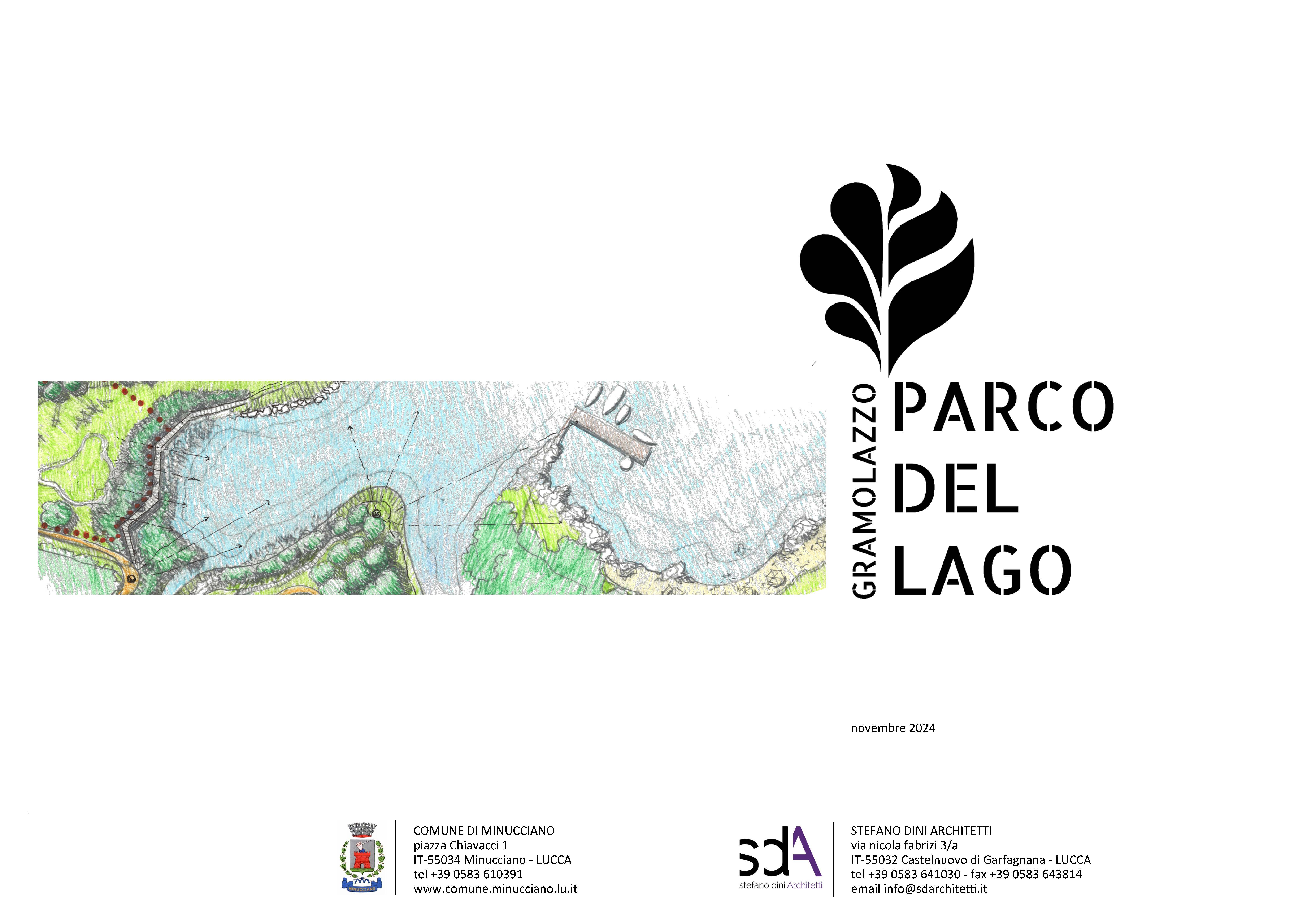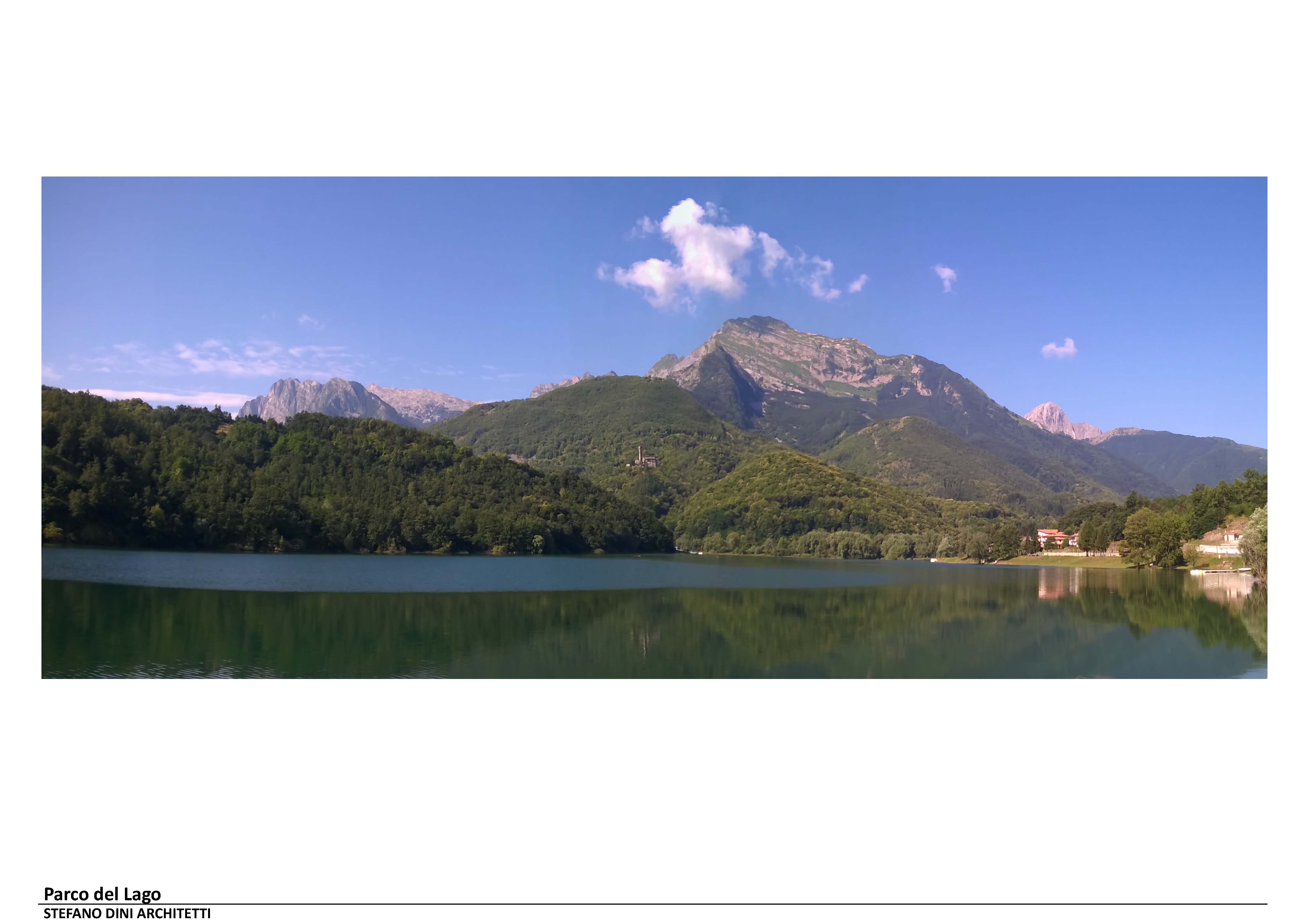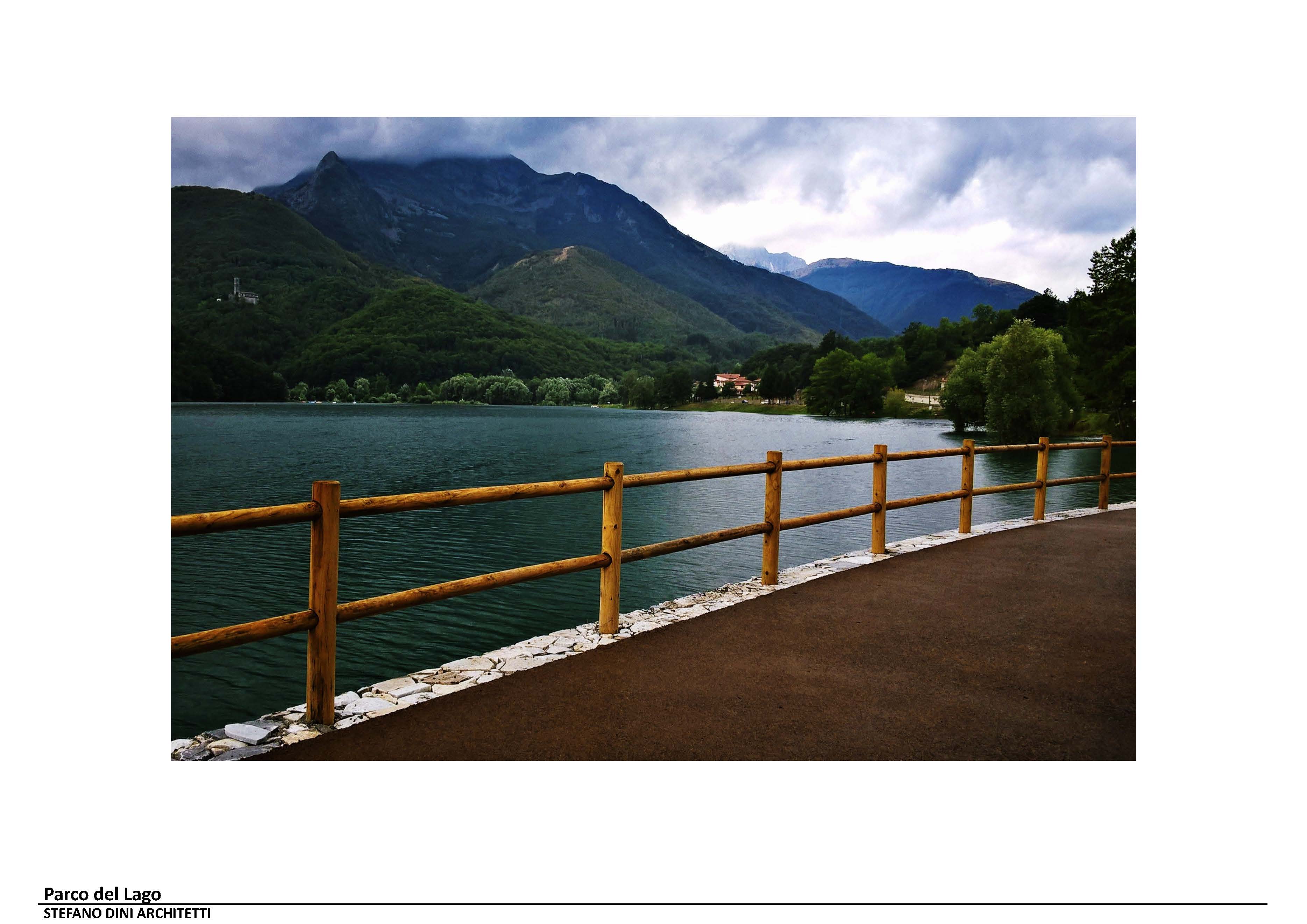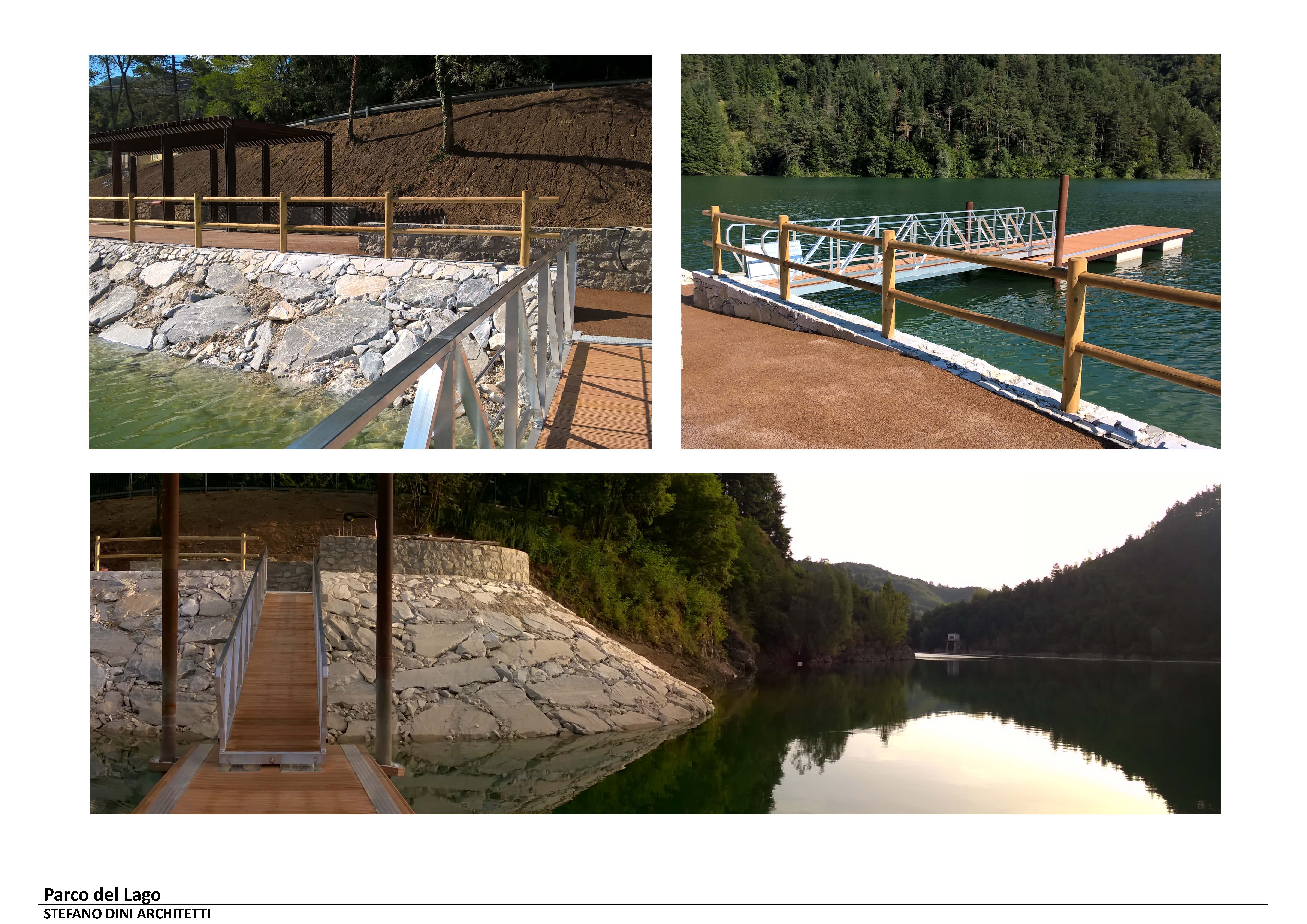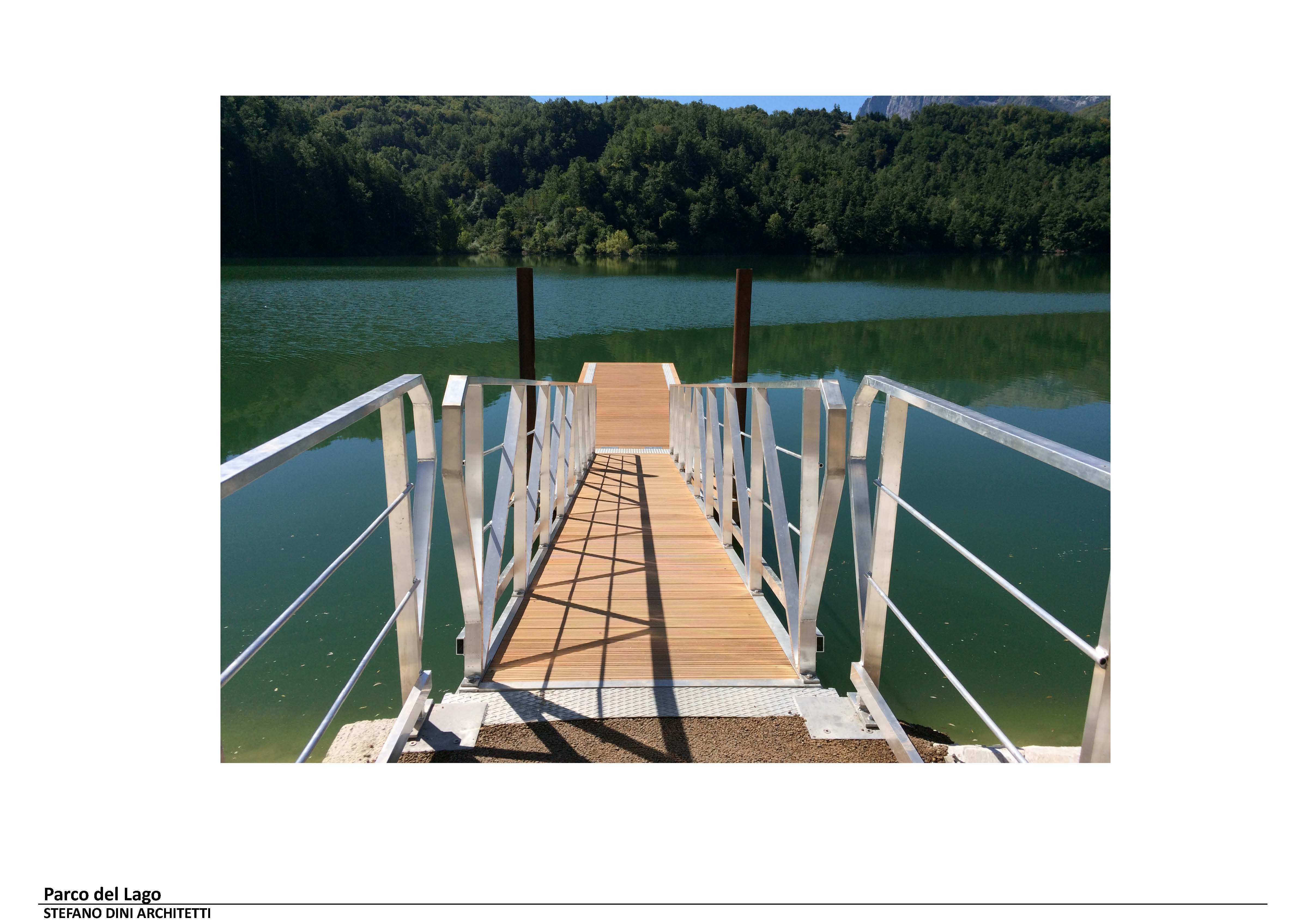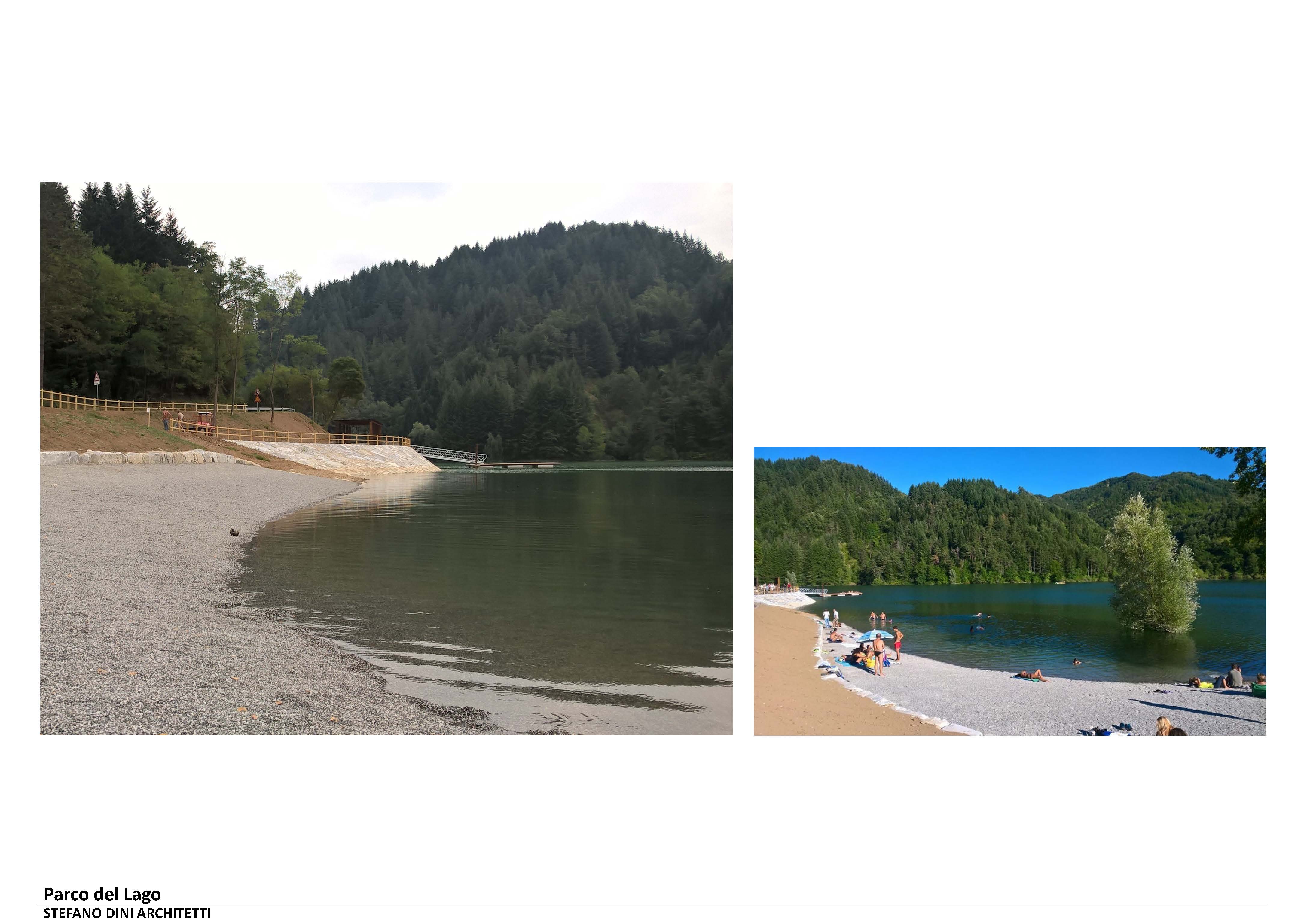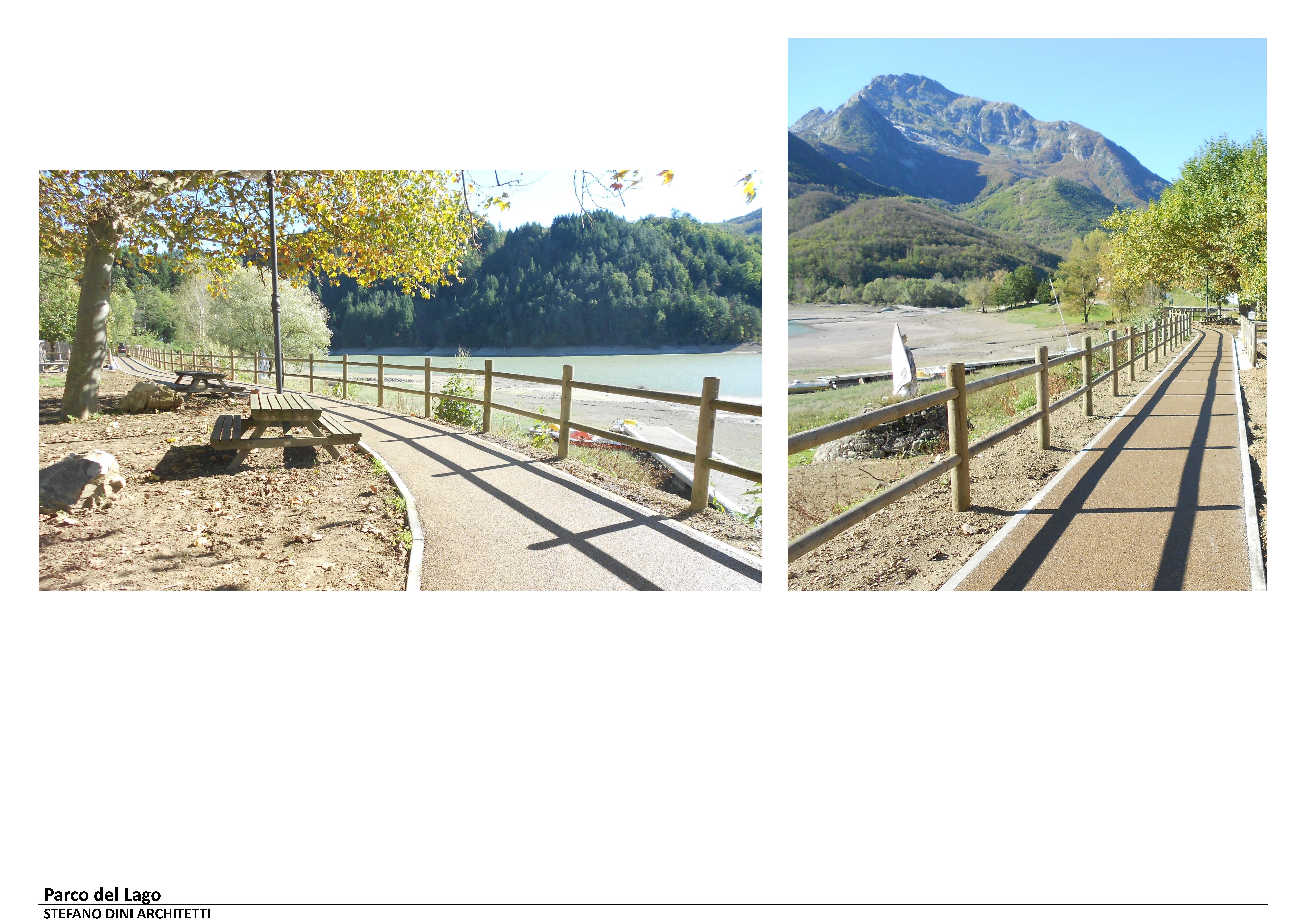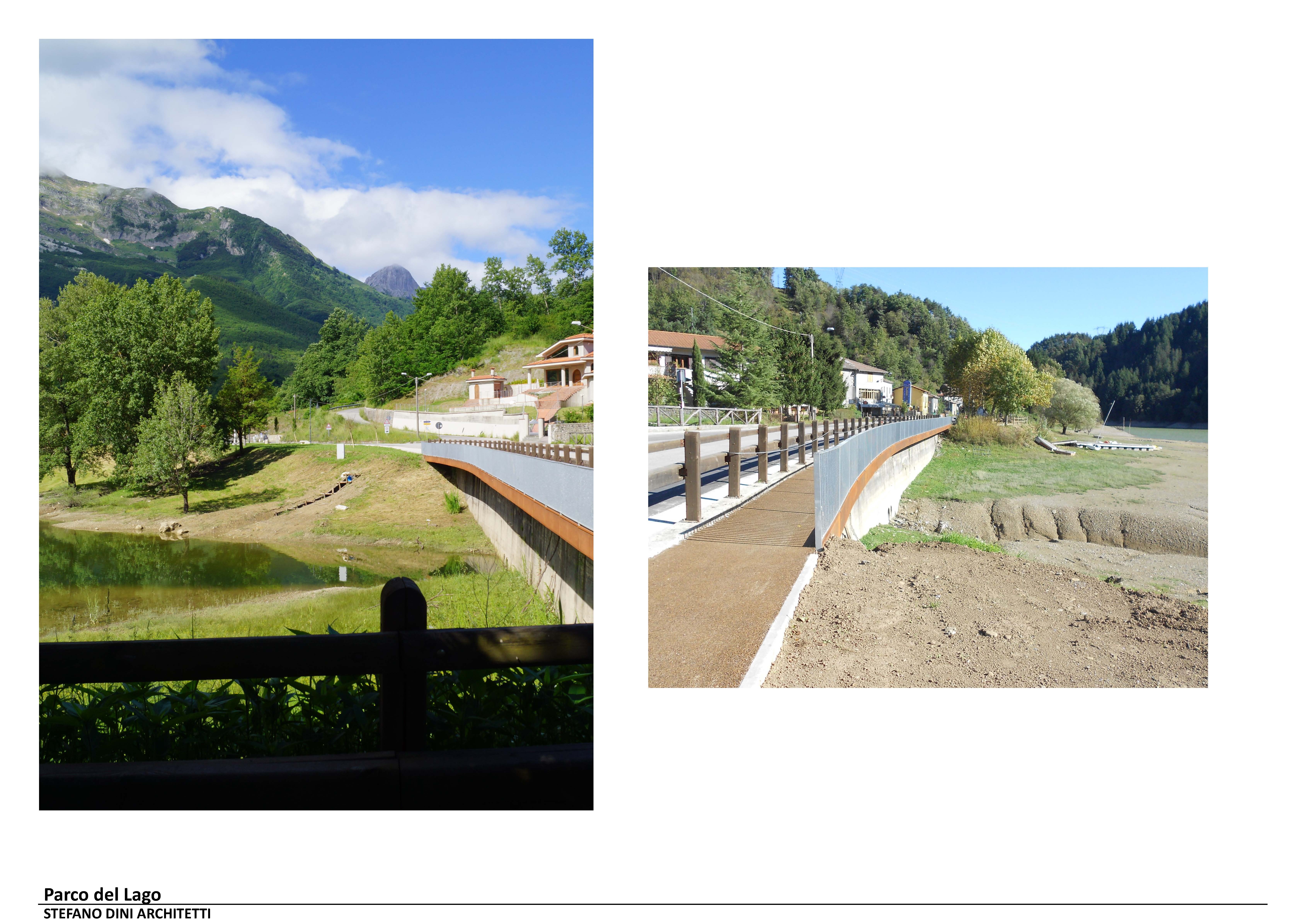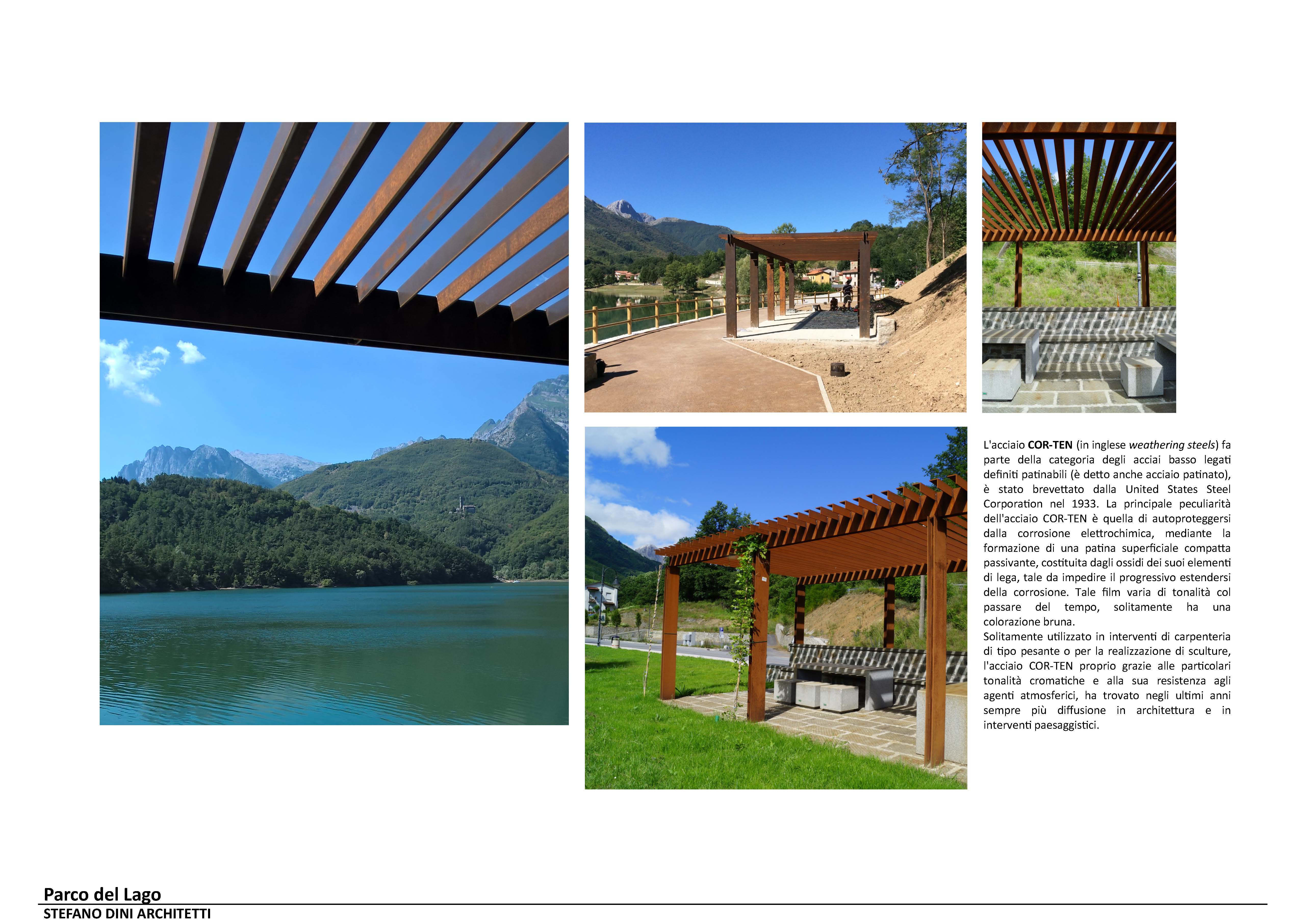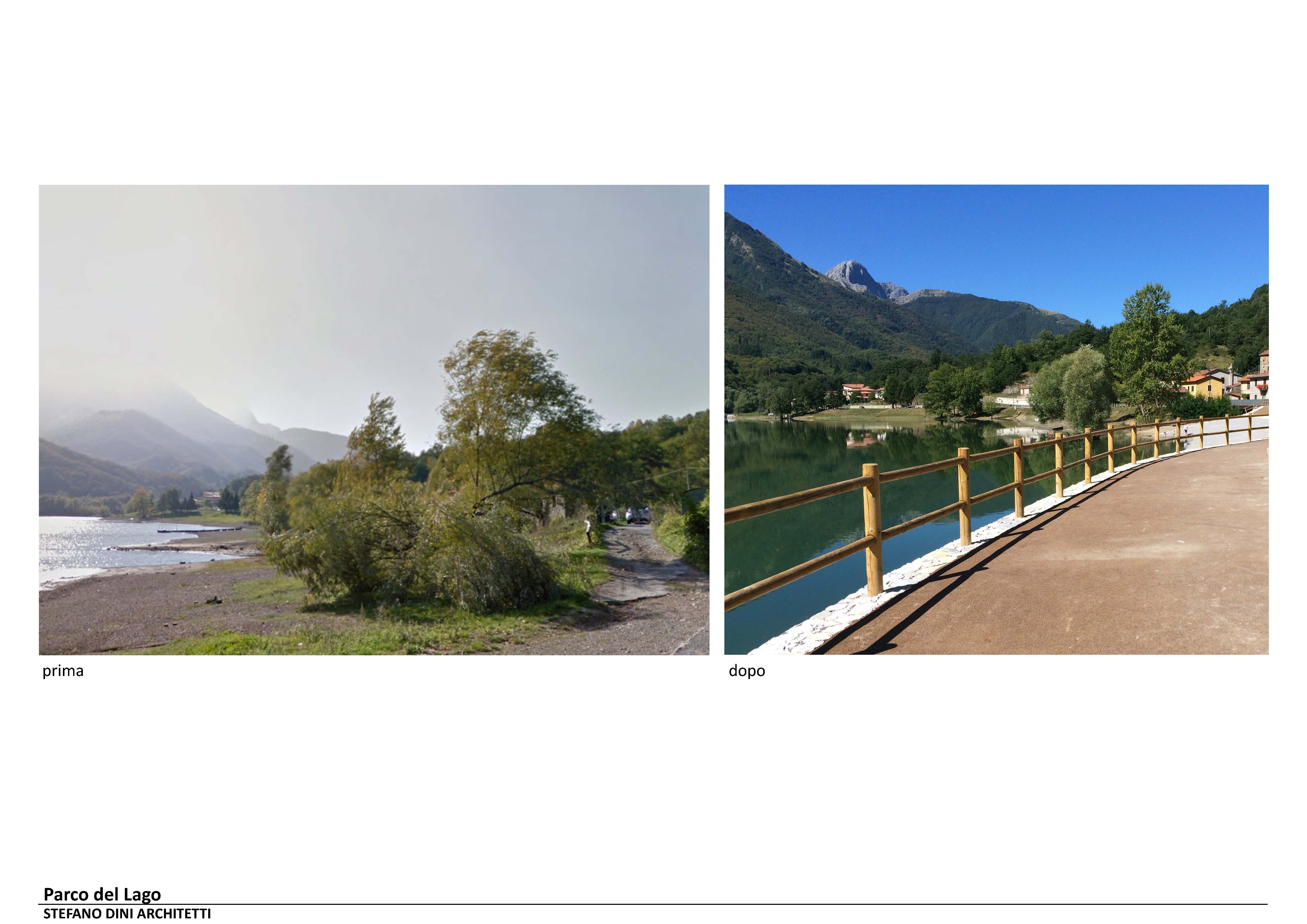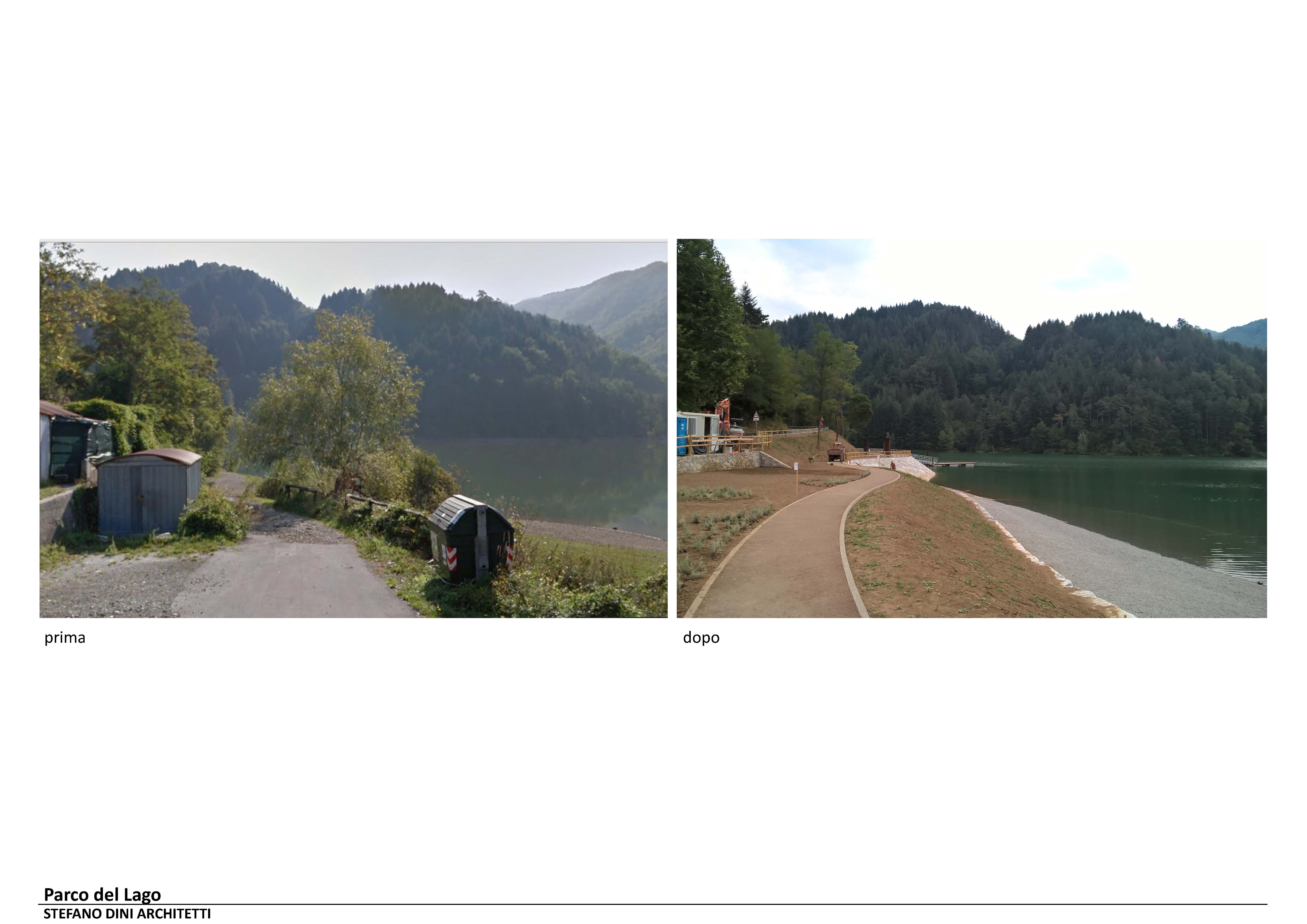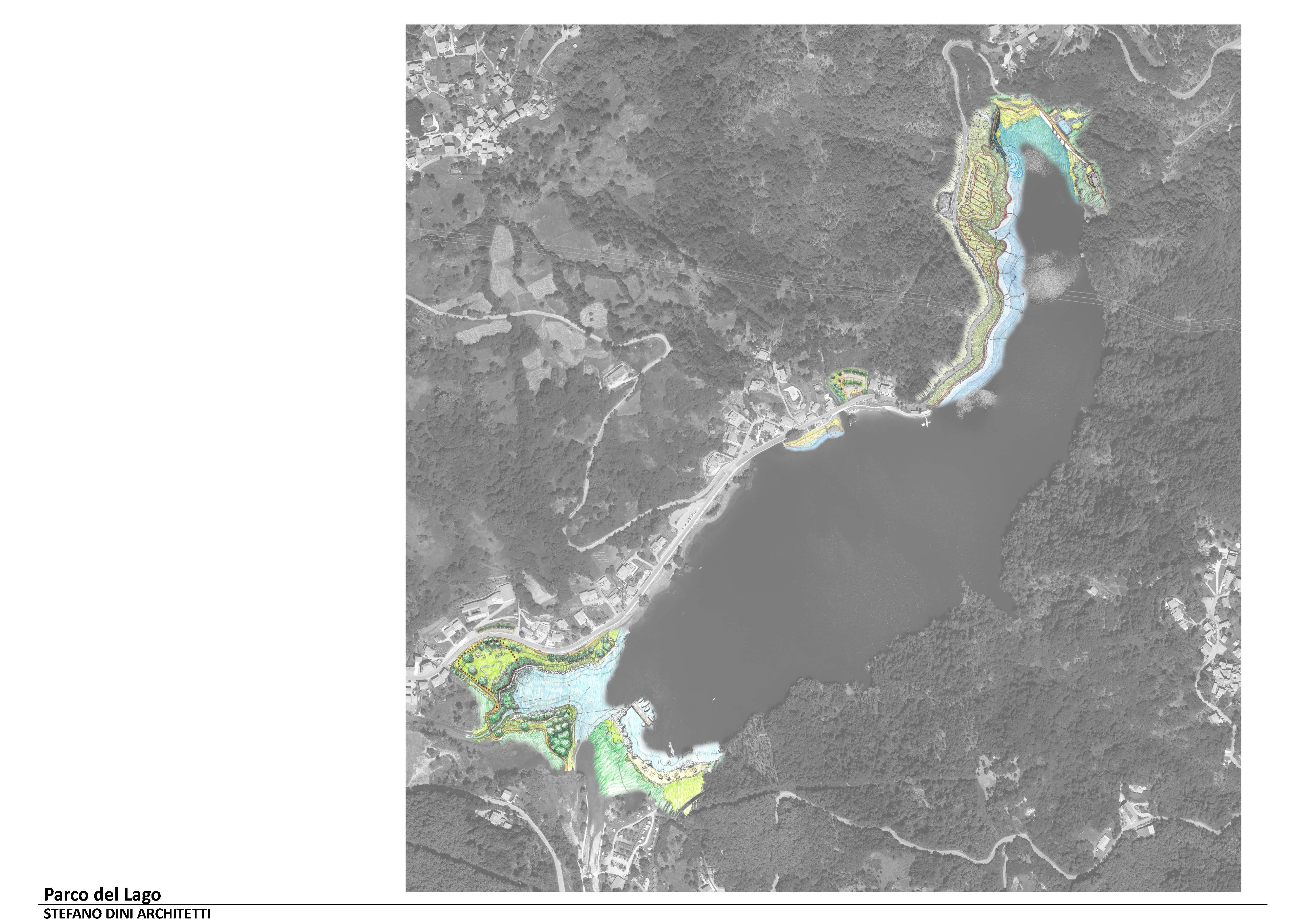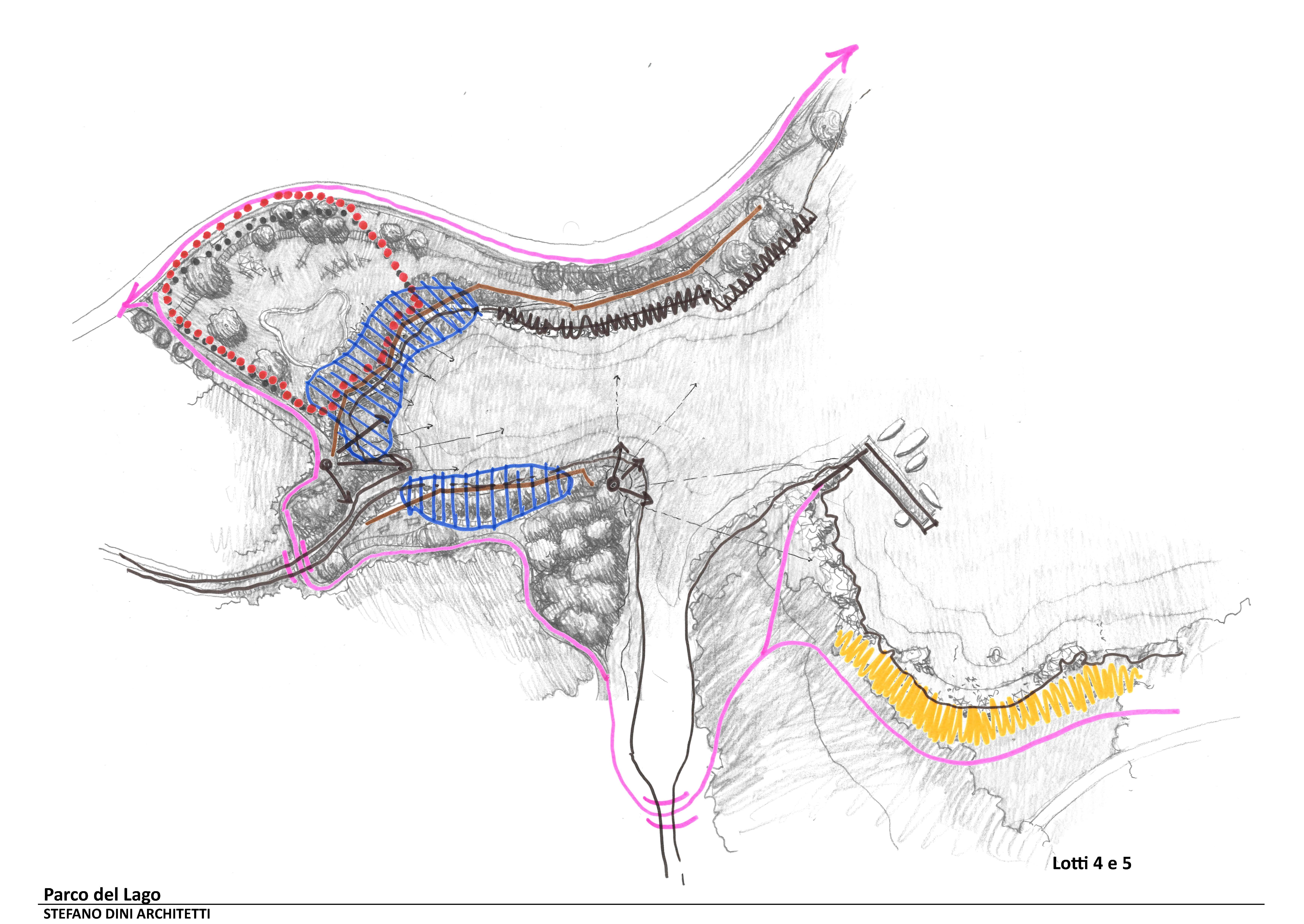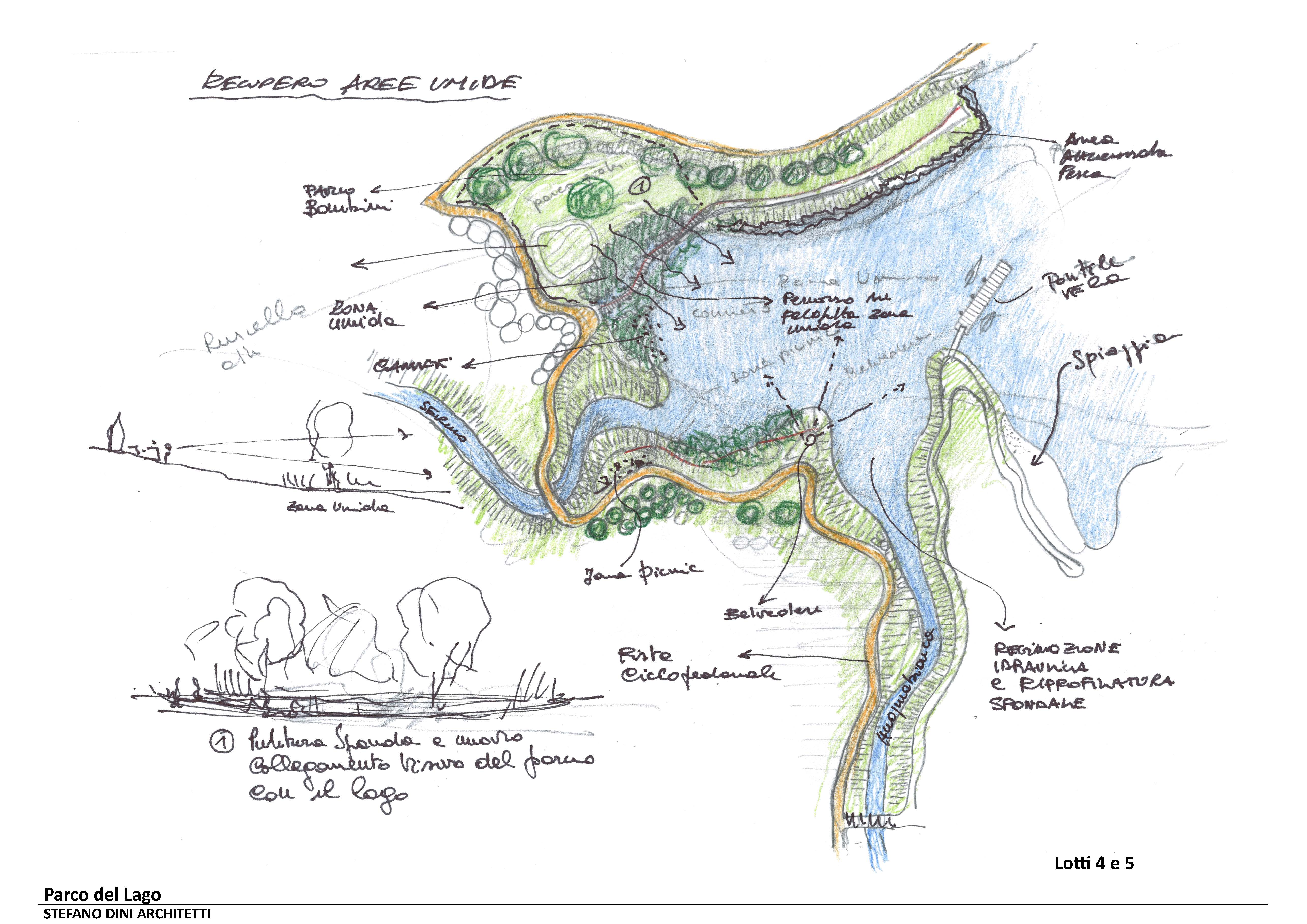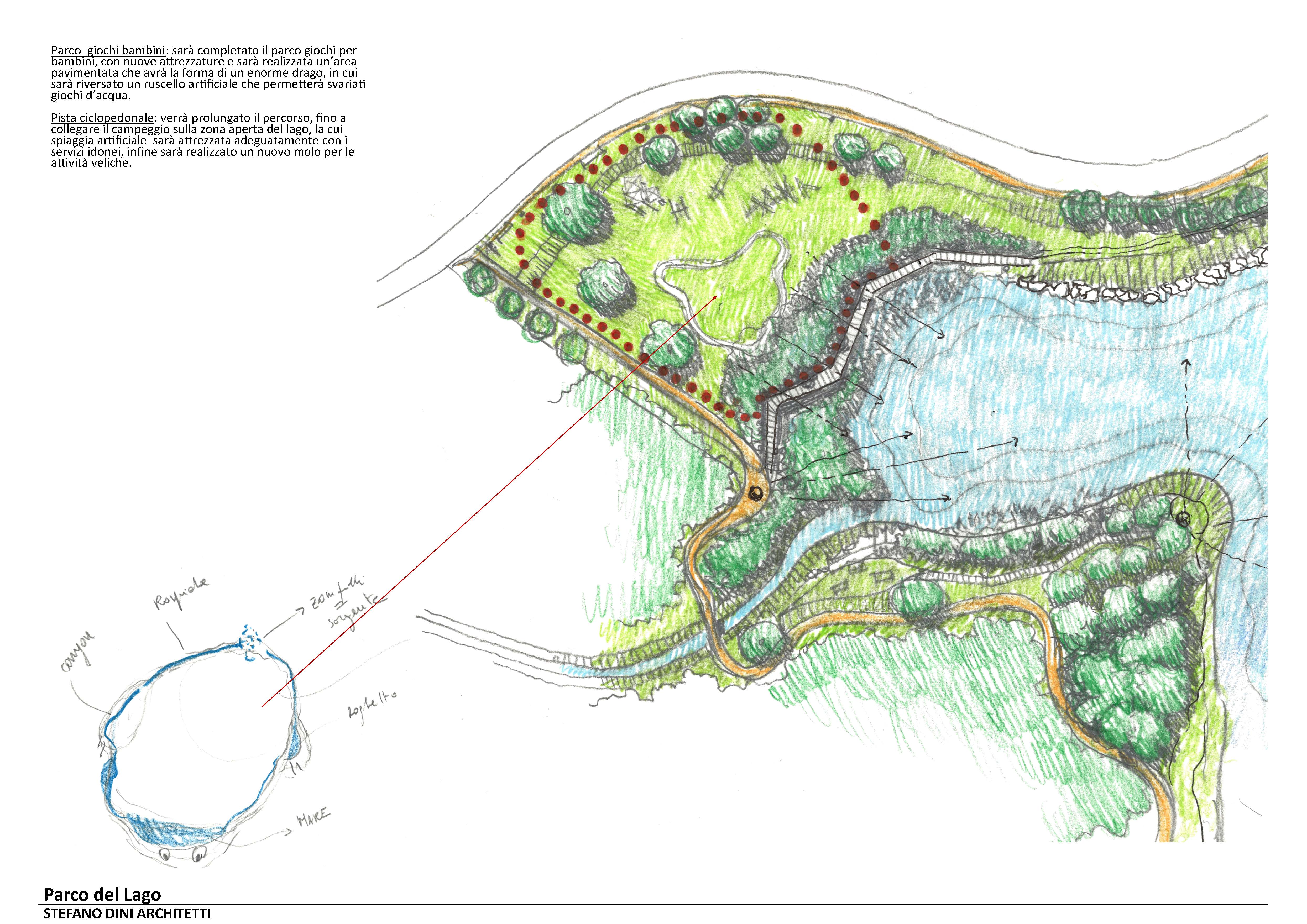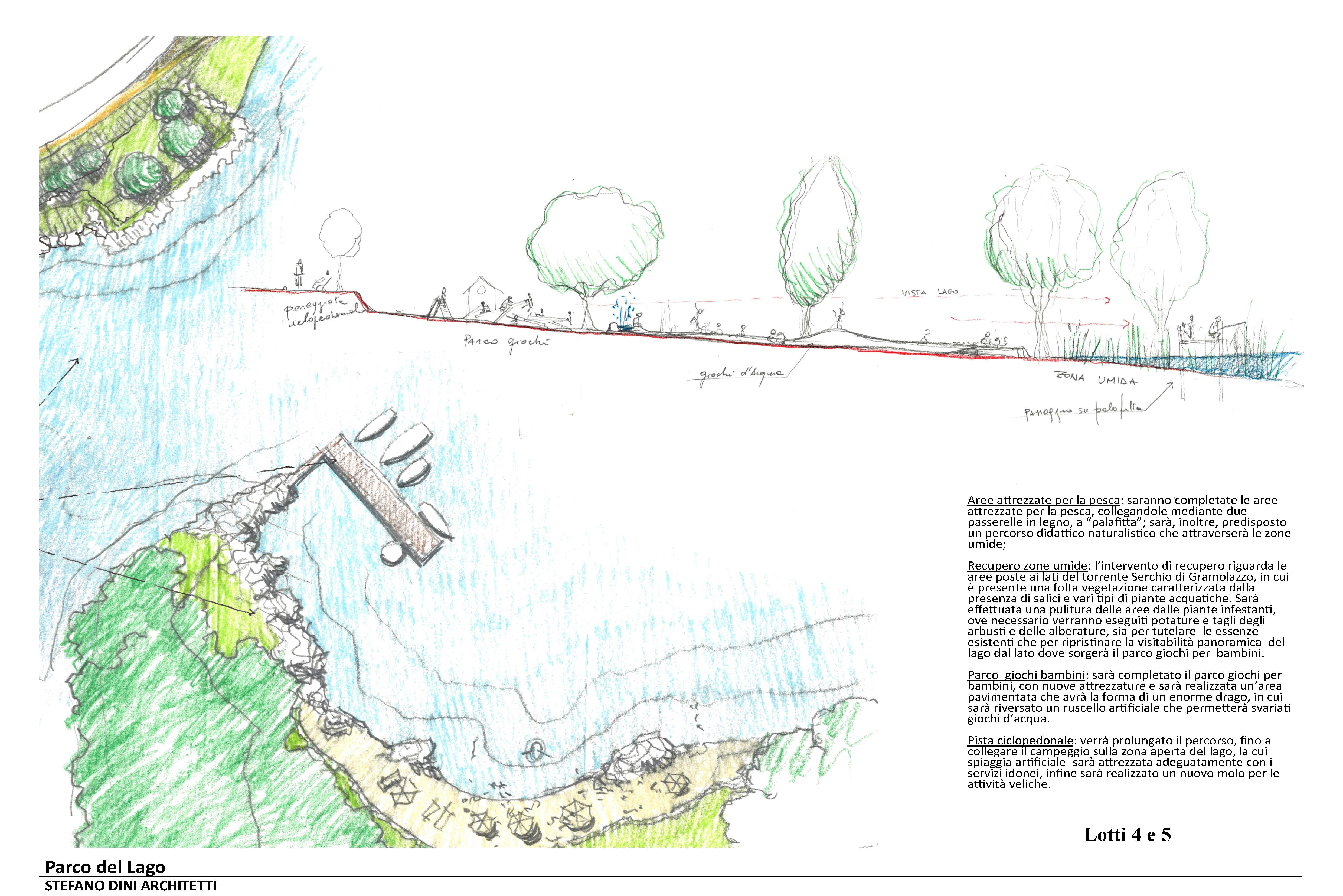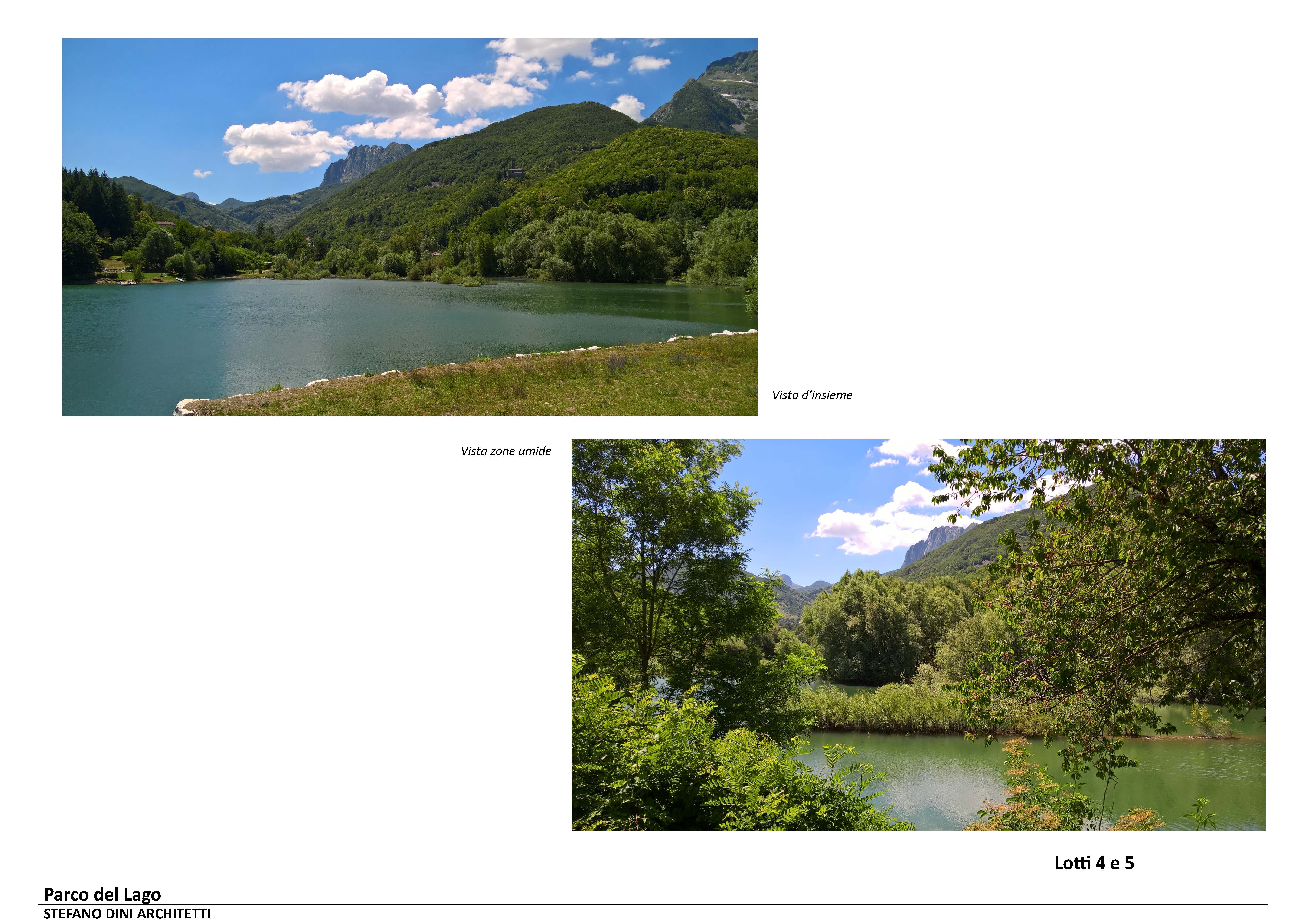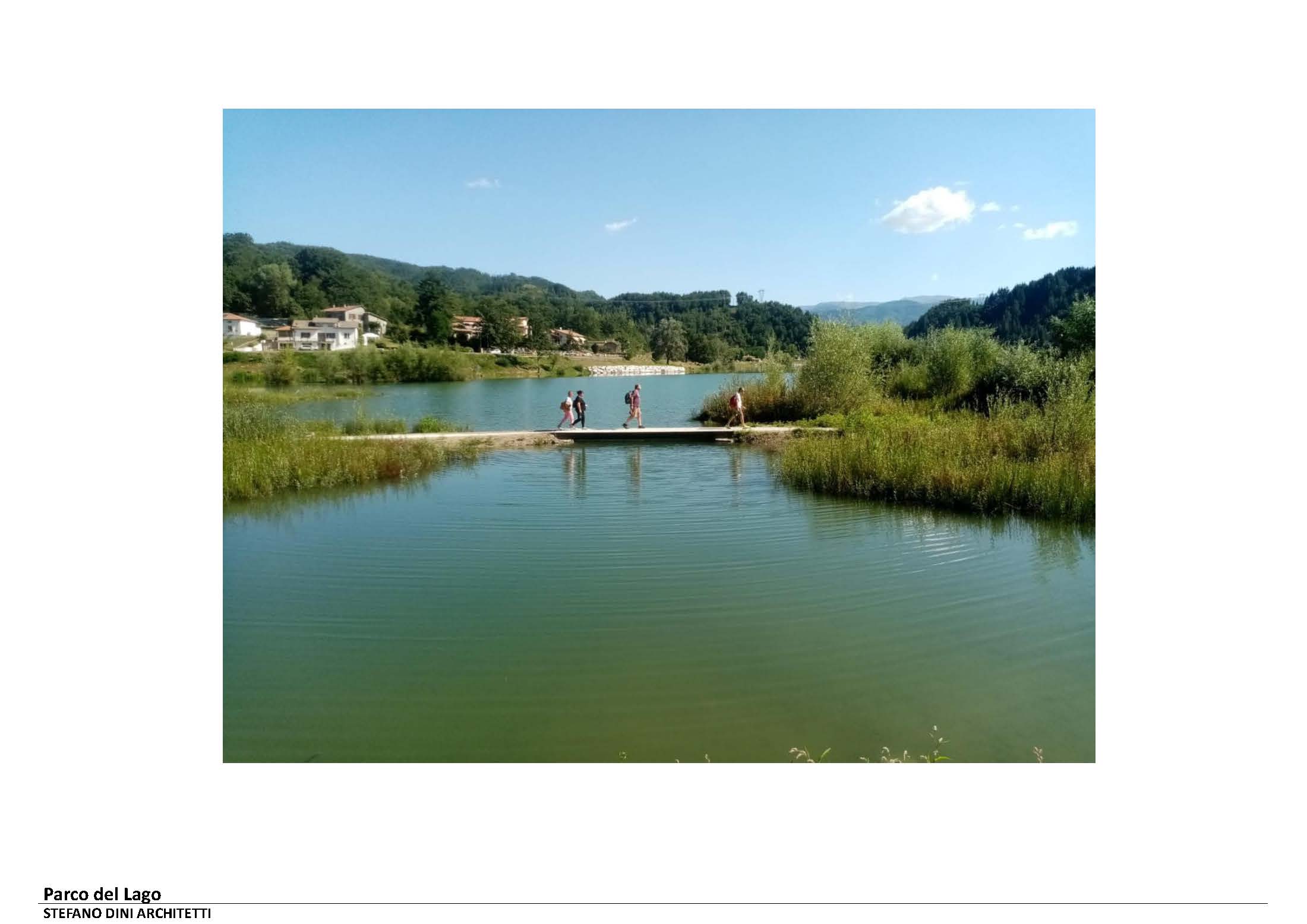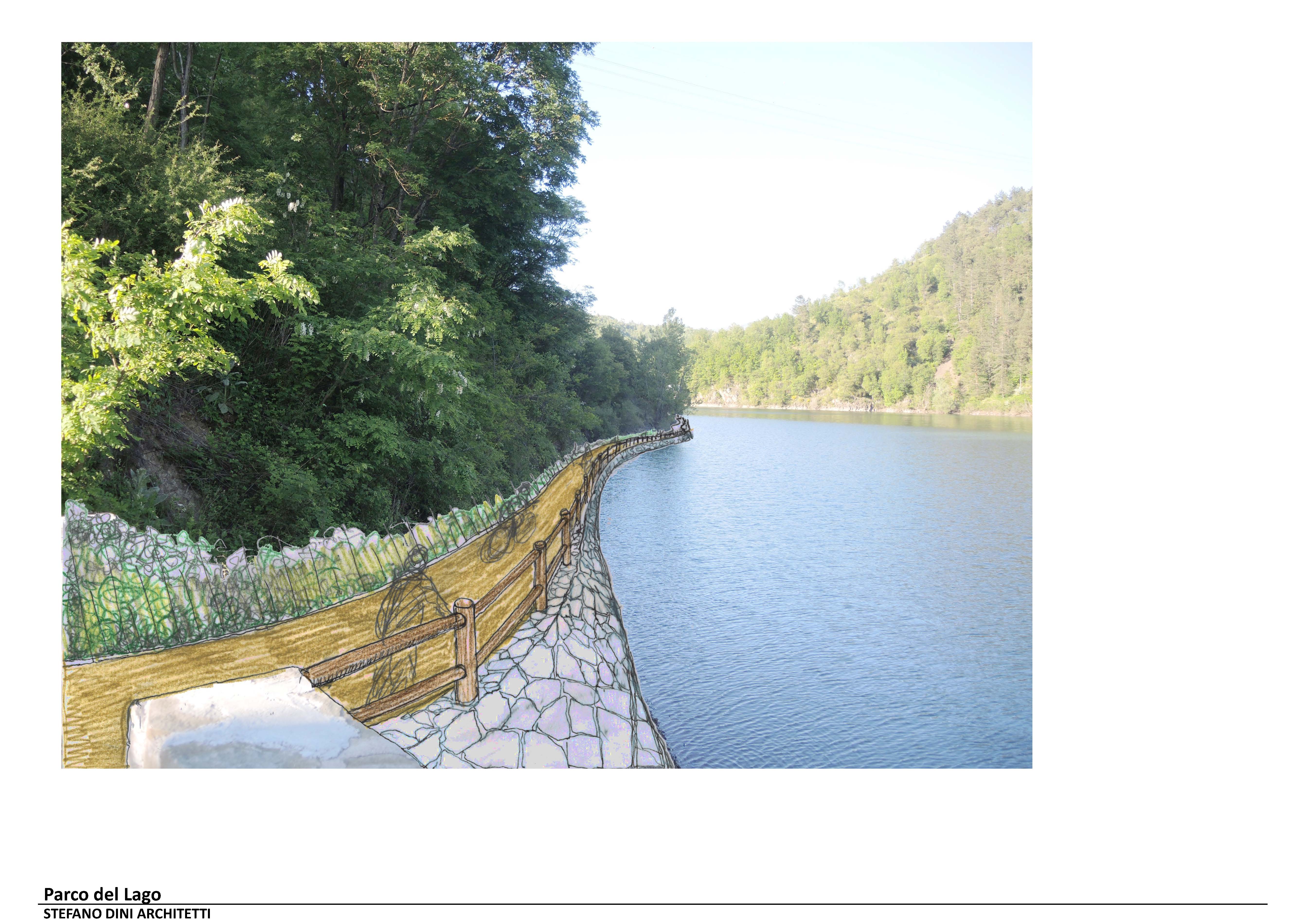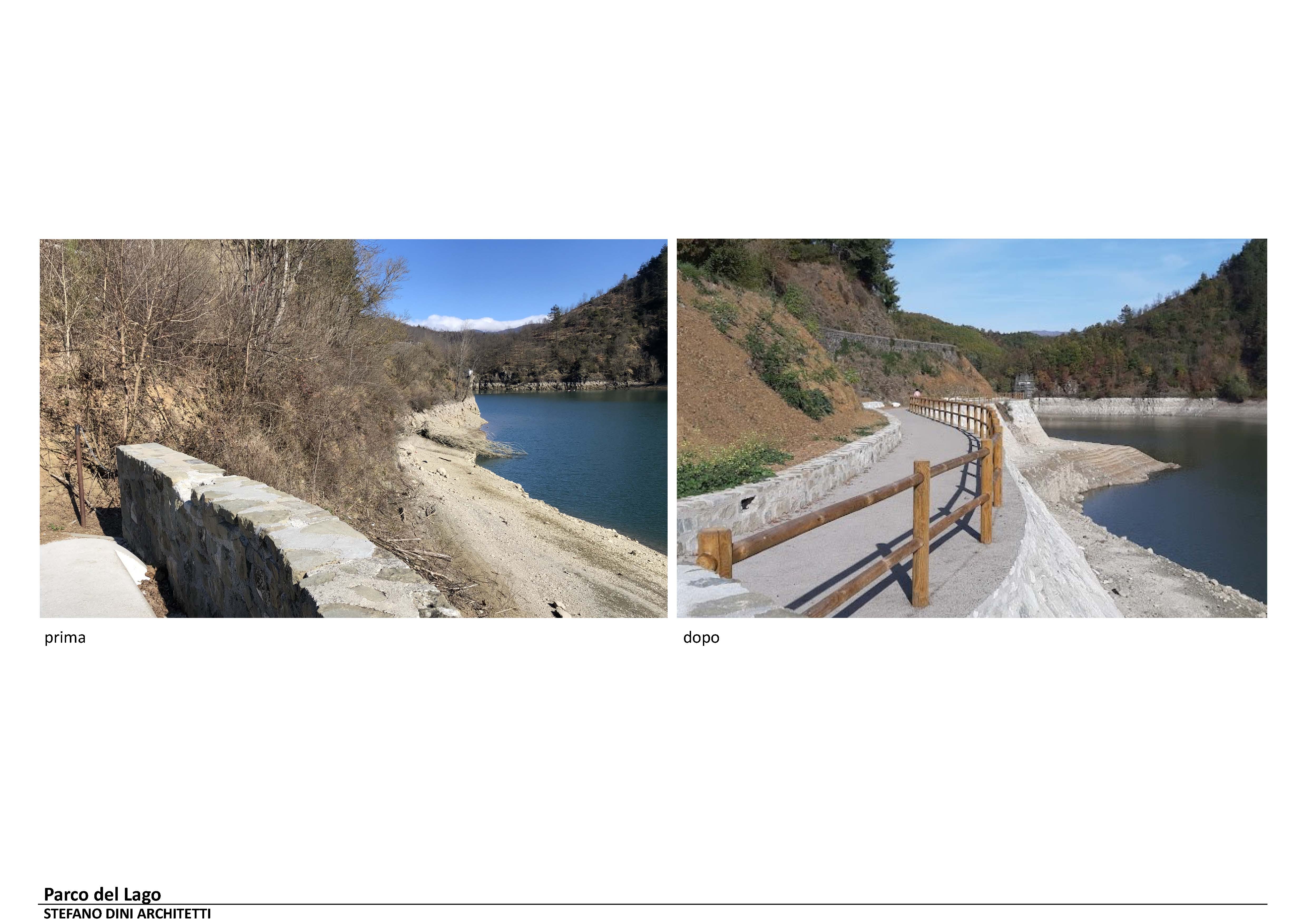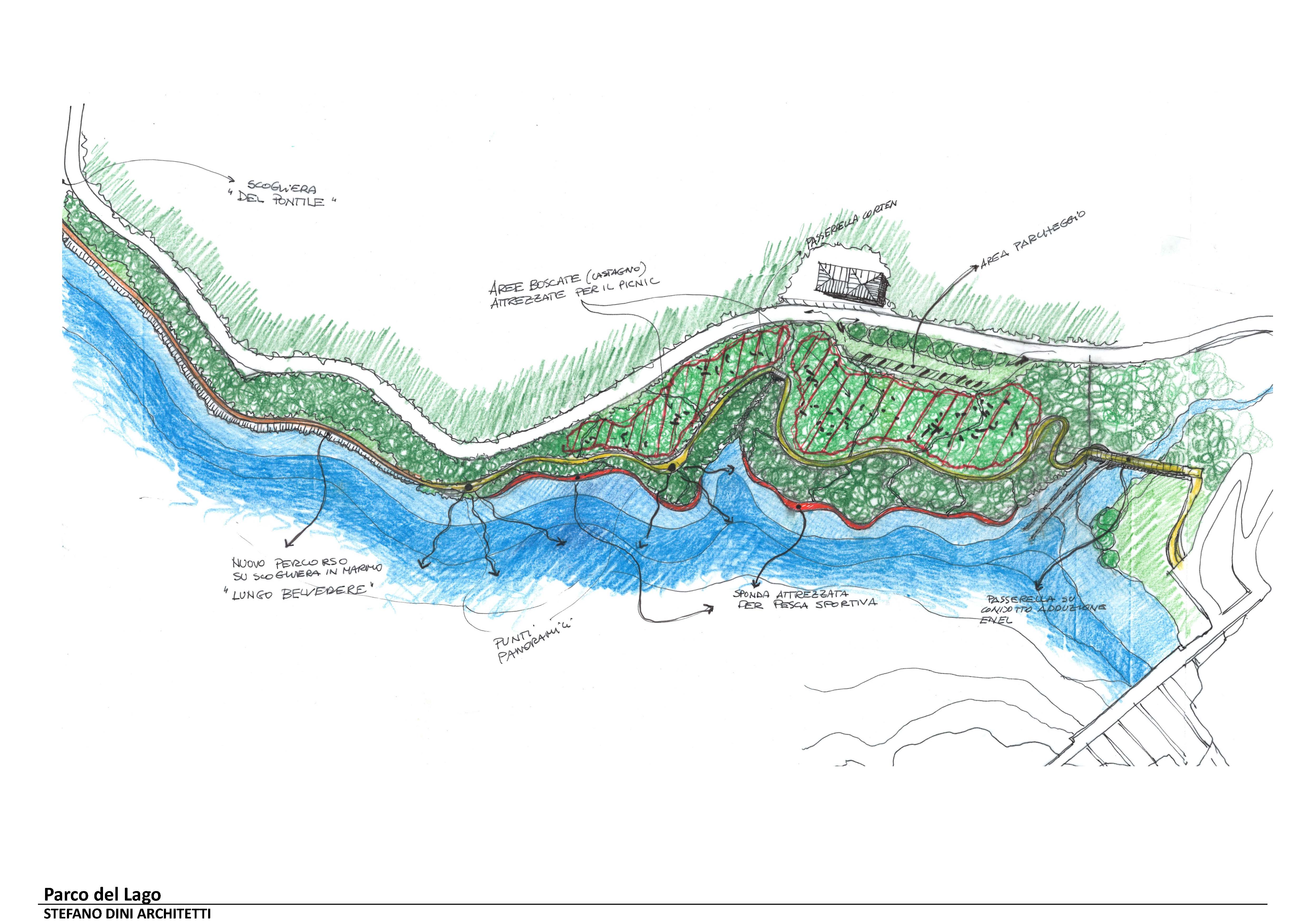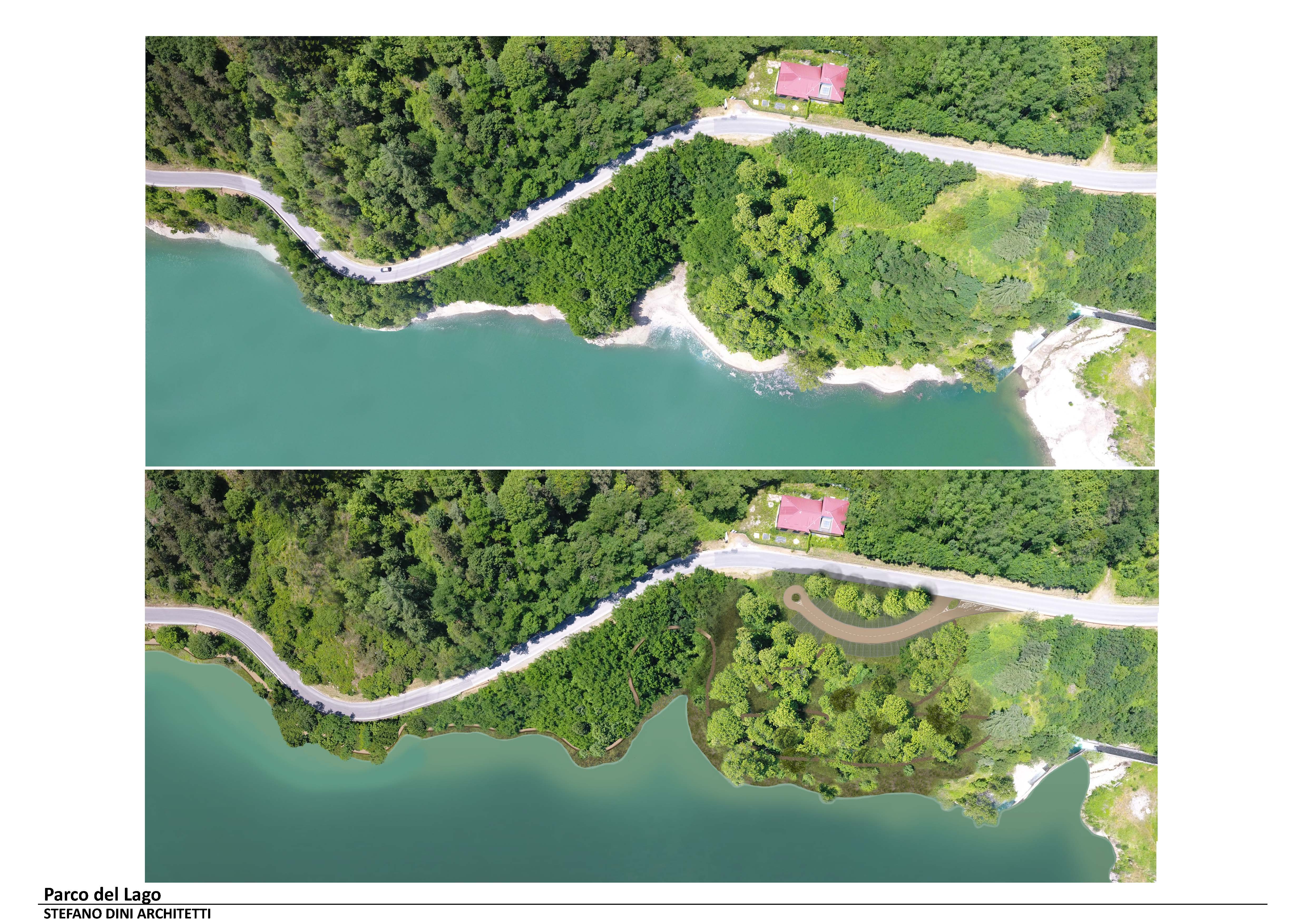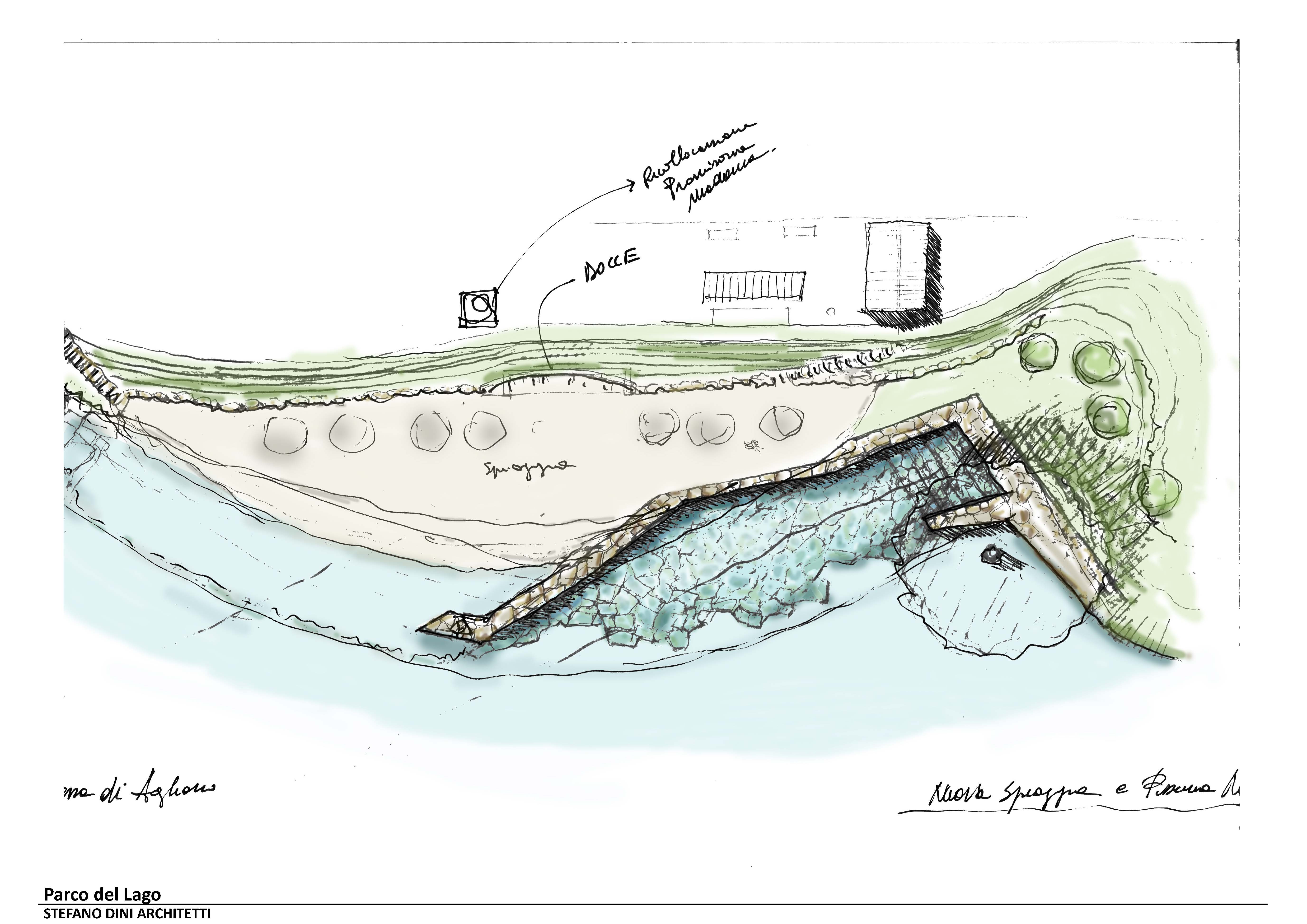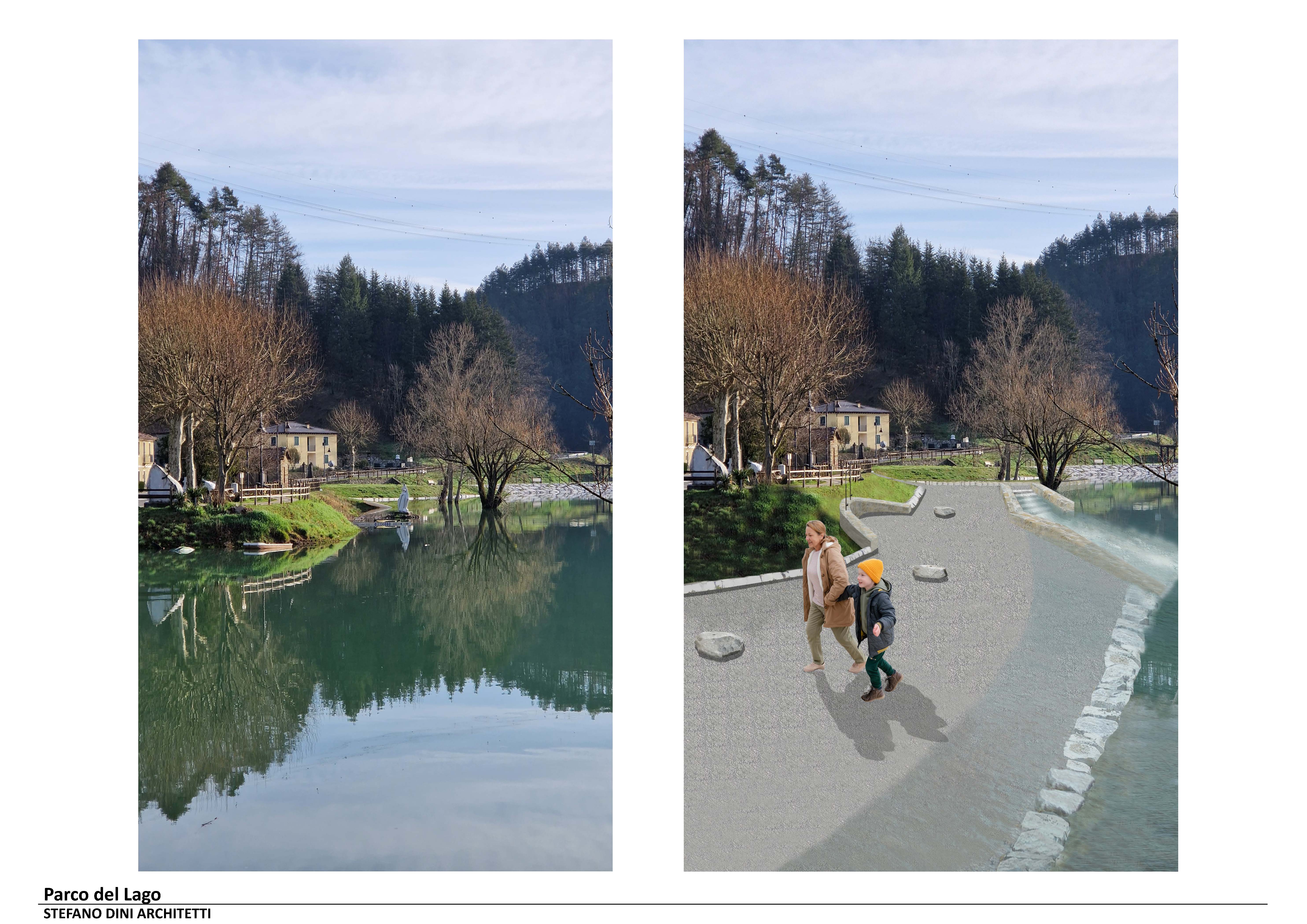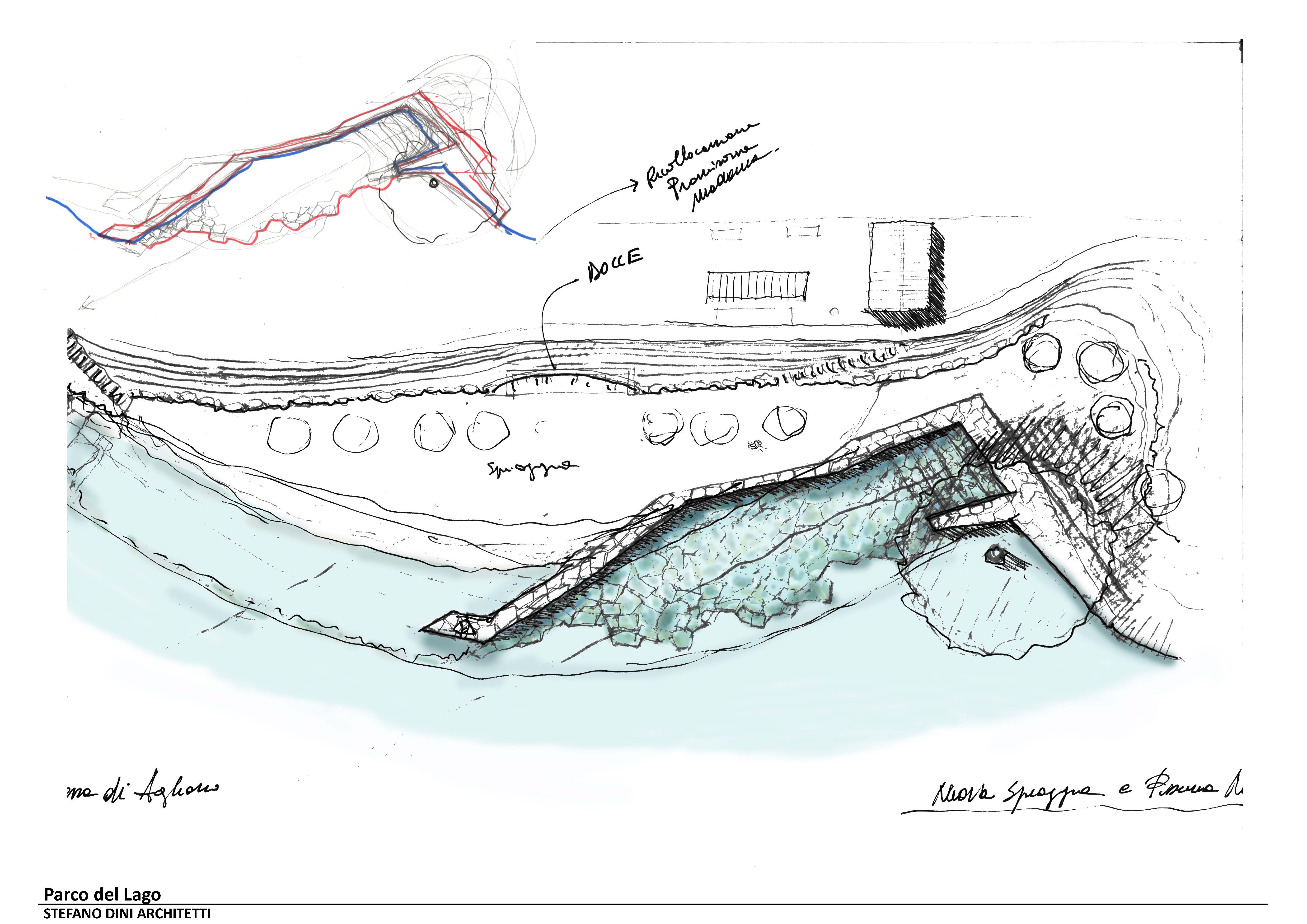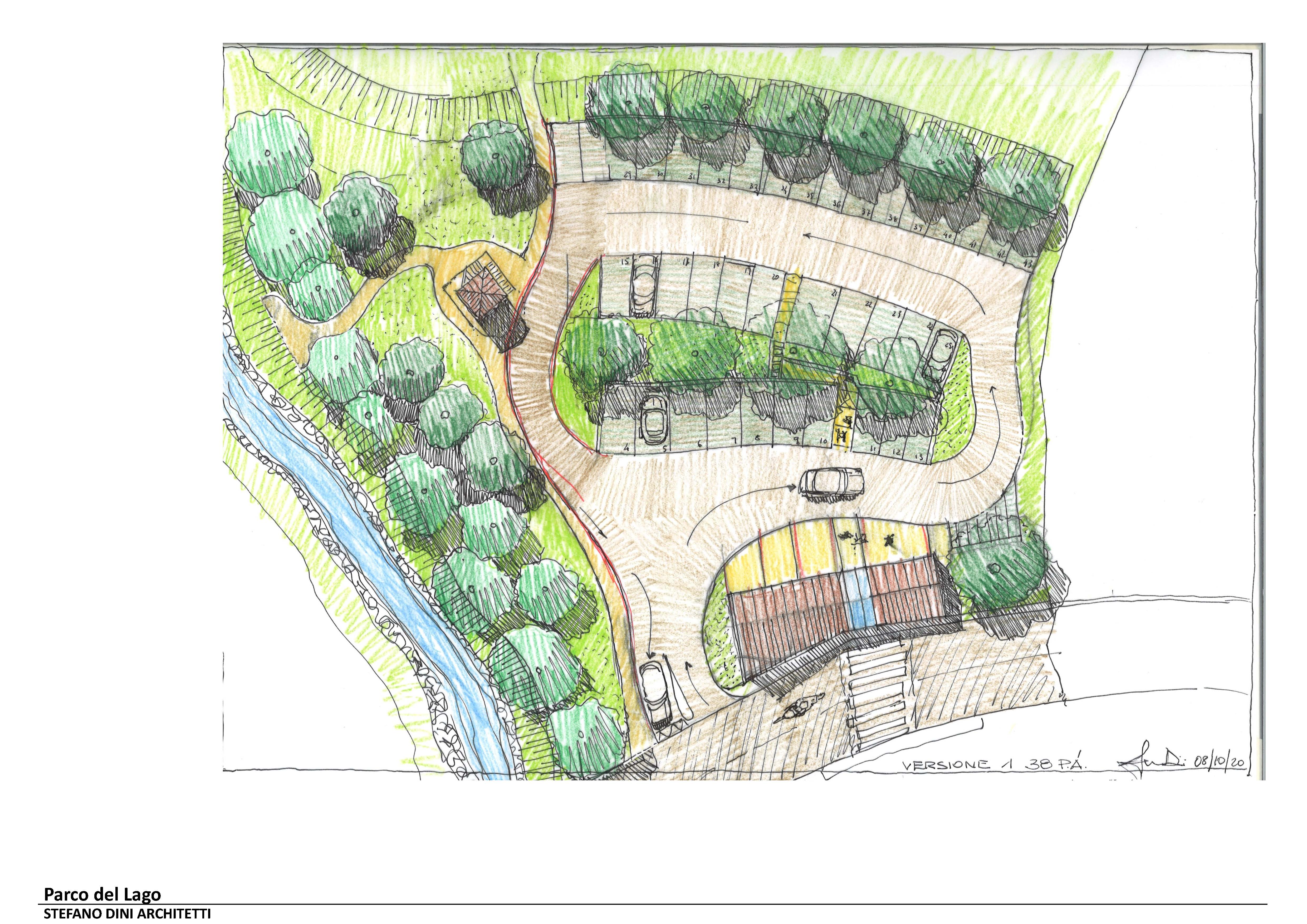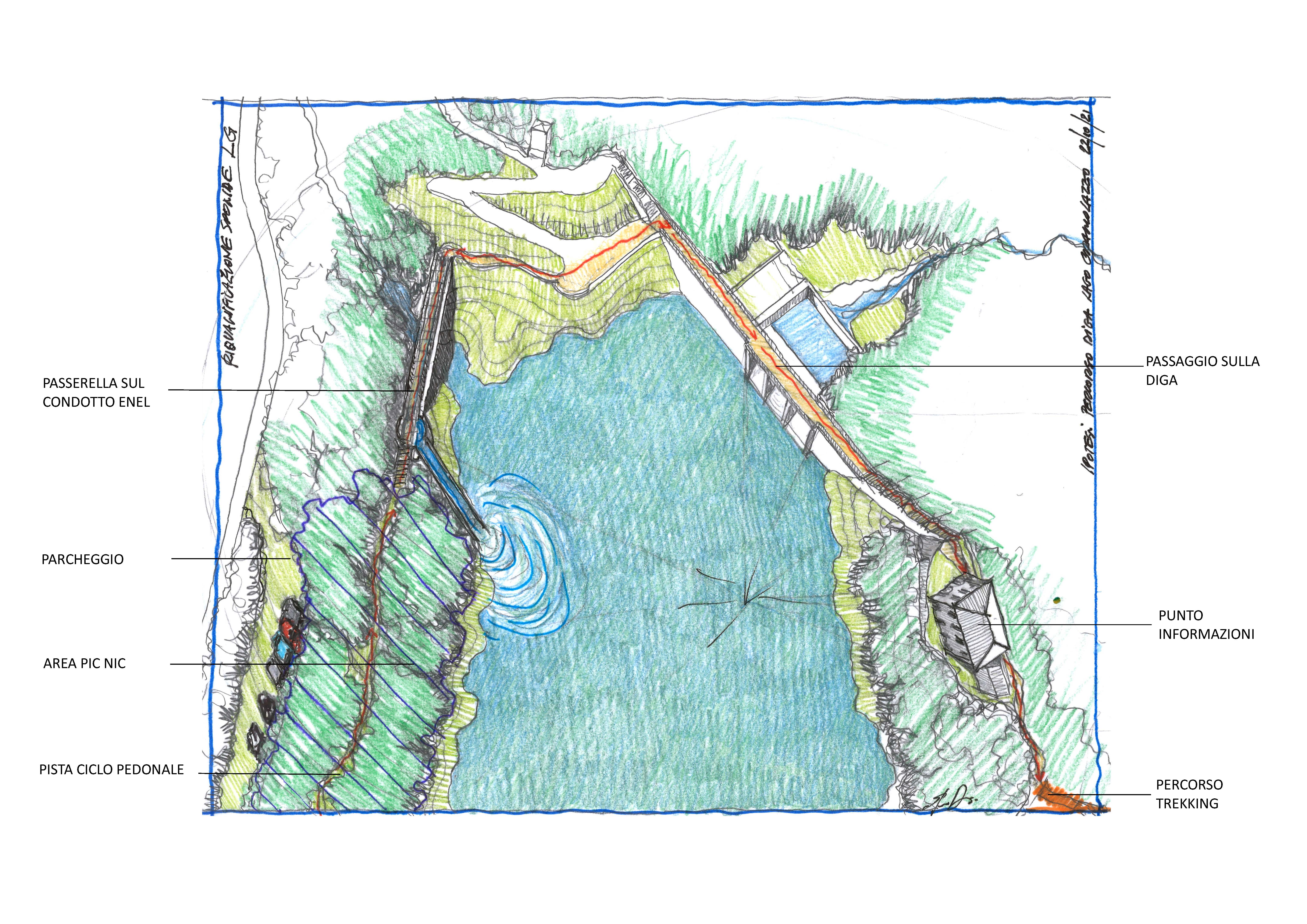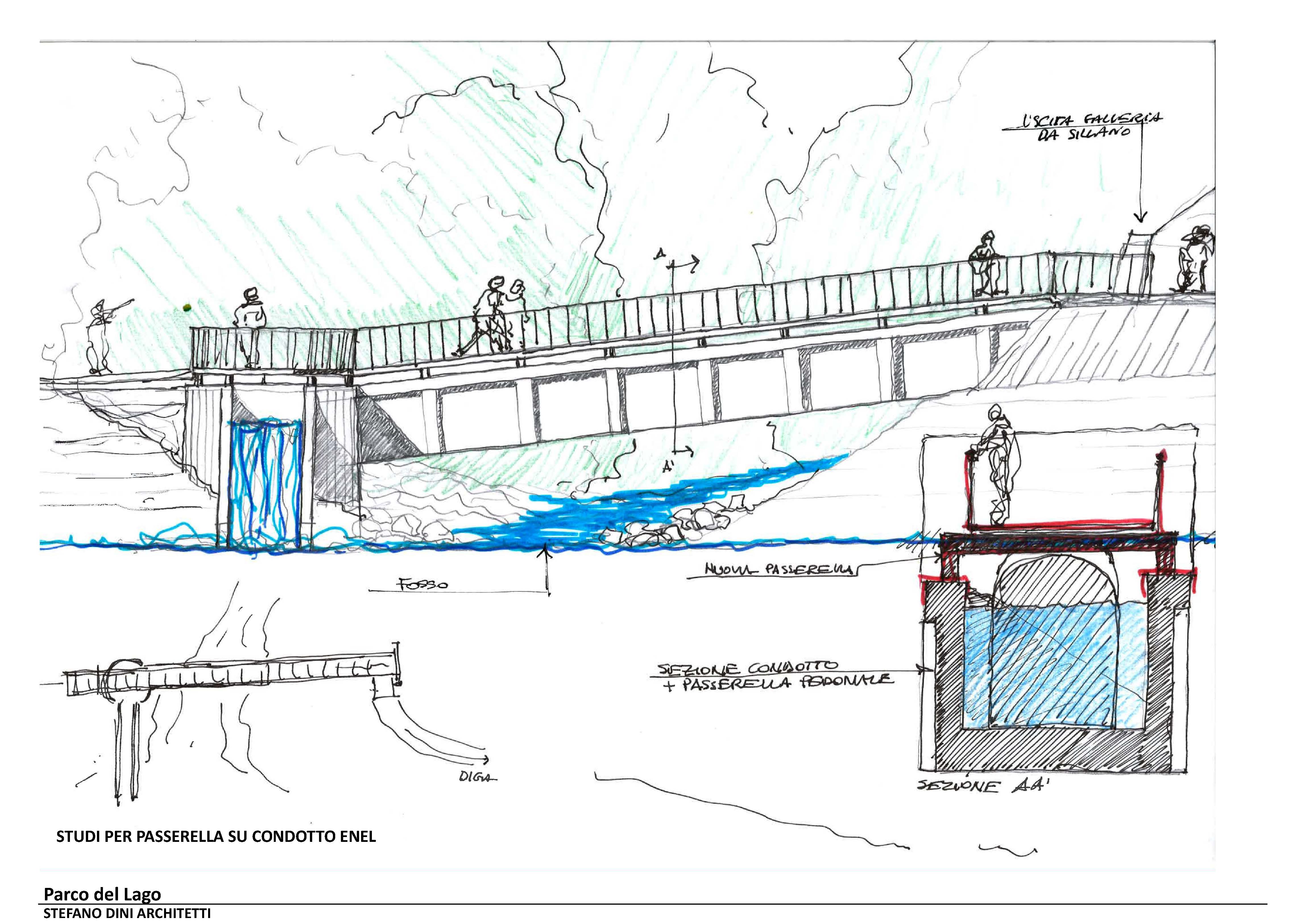Gramolazzo Lake meets the NEB challenges
Integration of New European Bauhaus principles in the sustainable regeneration of Gramolazzo Lake
Thanks to the support of an Interreg Euro-MED programme project, BAUHAUS4MED, participated by the Regional Government of Tuscany, the NEB principles and approaches are being widely implemented to add societal value and environmental sustainability to an ongoing infrastructural regeneration programme for the Gramolazzo Lake in the Municipality of Minucciano (Tuscany, Italy).
Italy
Lake of Gramolazzo, Municipality of Minucciano, Province of Lucca, Region of Tuscany
Prototype level
Yes
Yes
Yes
Yes
ERDF : European Regional Development Fund
POR Creo Regione Toscana 2007-2013 & 2014-2020 - directly to the Municipality of Minucciano
+ Interreg Euro-MED programme 2021-2027 via the Regional Government of Tuscany (partner of BAUHAUS4MED project)
+ Interreg Euro-MED programme 2021-2027 via the Regional Government of Tuscany (partner of BAUHAUS4MED project)
No
046019: Minucciano (IT)
The initiative, part of the Interreg Euro-Med 2021-2027 project "BAUHAUS4MED", implemented by the Tuscan Regional Government partner of the project, aims to promote local development in Gramolazzo, Minucciano (Tuscany, Italy), in the Natural Park of the Apuan Alps, by transforming the area into a model of environmental, social, and economic sustainability and resilience. The project targets the local community, particularly addressing demographic decline and youth disengagement, while also appealing to targeted tourists and to stakeholders in the marble artisanal and industrial factories.
Overall Aim:
To create a sustainable, inclusive, and aesthetically appealing local supply chain by reusing waste materials from marble extraction, while enhancing the socio-economic and ecological values of Gramolazzo Lake’s shores and the slow fruition of its surroundings.
Target Groups:
Local residents, especially youth, affected by job scarcity.
Tourists, sporties, and nature enthusiasts.
Artisanal and industrial stakeholders in the marble sector.
Public and private entities involved in urban and regional regeneration and in ecosystems conservation.
Specific Objectives:
Redevelop neglected areas around Gramolazzo Lake to boost tourism and local services.
Establish an innovative supply chain for transforming marble waste into urban furniture and design elements.
Promote participatory decision-making and community engagement.
Enhance the area’s ecological and socio-economic sustainability.
Expected Outcomes:
Increased tourist visits and economic activity.
Creation of new jobs and opportunities in artisanal and industrial sectors.
Improved environmental sustainability through waste reuse.
Strengthened community involvement and urban regeneration.
Replicability of the model in other regions with water basins.
This initiative integrates urban and regional planning, environmental protection, and economic development to create a resilient and attractive community.
Overall Aim:
To create a sustainable, inclusive, and aesthetically appealing local supply chain by reusing waste materials from marble extraction, while enhancing the socio-economic and ecological values of Gramolazzo Lake’s shores and the slow fruition of its surroundings.
Target Groups:
Local residents, especially youth, affected by job scarcity.
Tourists, sporties, and nature enthusiasts.
Artisanal and industrial stakeholders in the marble sector.
Public and private entities involved in urban and regional regeneration and in ecosystems conservation.
Specific Objectives:
Redevelop neglected areas around Gramolazzo Lake to boost tourism and local services.
Establish an innovative supply chain for transforming marble waste into urban furniture and design elements.
Promote participatory decision-making and community engagement.
Enhance the area’s ecological and socio-economic sustainability.
Expected Outcomes:
Increased tourist visits and economic activity.
Creation of new jobs and opportunities in artisanal and industrial sectors.
Improved environmental sustainability through waste reuse.
Strengthened community involvement and urban regeneration.
Replicability of the model in other regions with water basins.
This initiative integrates urban and regional planning, environmental protection, and economic development to create a resilient and attractive community.
Sustainability
Urban and Regional Regeneration
Community Participation
Slow Tourism
Circular Economy
Waste Reduction and Circular Economy: The initiative aims to transform marble waste (carbonate earth and debris) into valuable products like urban furniture and design elements. This reduces landfill use, promotes resource efficiency, and establishes a circular economy model.
Environmental Regeneration: By redeveloping the neglected shores of Lake Gramolazzo, the project enhances biodiversity, improves water quality, and integrates ecological considerations into spatial design and planning.
Climate Resilience: The initiative aligns with EU climate goals by promoting mitigating practices in industrial and artisanal activities, reducing carbon footprints, and fostering renewable energy awareness, while preserving local ecosystems to also help supralocal adaptation.
Sustainable Tourism: The creation of eco-friendly slow infrastructures (e.g., cycling routes, hiking trails, and small artificial beaches) boosts tourism while minimizing environmental impact.
How These Objectives Are Met:
Innovative Supply Chain: Local artisans and industries are encouraged to adopt sustainable practices, such as reusing waste materials.
Community Involvement: Residents participate in decision-making, ensuring solutions are locally relevant and sustainable.
Partnerships: Collaboration with stakeholders like Enel Produzione SpA and the University of Florence ensures expertise and resources are leveraged effectively.
Regional Government support: Gramolazzo is the area selected to implement the BAUHAUS4MED Project pilot action.
Exemplary Nature:
The initiative is a replicable model for regions facing similar challenges, demonstrating how sustainability can drive economic revitalization, environmental protection, and social inclusion. By integrating waste reuse, ecological restoration, and community engagement, it sets a benchmark for sustainable development in line with EU priorities.
Environmental Regeneration: By redeveloping the neglected shores of Lake Gramolazzo, the project enhances biodiversity, improves water quality, and integrates ecological considerations into spatial design and planning.
Climate Resilience: The initiative aligns with EU climate goals by promoting mitigating practices in industrial and artisanal activities, reducing carbon footprints, and fostering renewable energy awareness, while preserving local ecosystems to also help supralocal adaptation.
Sustainable Tourism: The creation of eco-friendly slow infrastructures (e.g., cycling routes, hiking trails, and small artificial beaches) boosts tourism while minimizing environmental impact.
How These Objectives Are Met:
Innovative Supply Chain: Local artisans and industries are encouraged to adopt sustainable practices, such as reusing waste materials.
Community Involvement: Residents participate in decision-making, ensuring solutions are locally relevant and sustainable.
Partnerships: Collaboration with stakeholders like Enel Produzione SpA and the University of Florence ensures expertise and resources are leveraged effectively.
Regional Government support: Gramolazzo is the area selected to implement the BAUHAUS4MED Project pilot action.
Exemplary Nature:
The initiative is a replicable model for regions facing similar challenges, demonstrating how sustainability can drive economic revitalization, environmental protection, and social inclusion. By integrating waste reuse, ecological restoration, and community engagement, it sets a benchmark for sustainable development in line with EU priorities.
Design Excellence: The initiative focuses on creating visually appealing urban furniture and design elements from marble waste, blending functionality with artistic value. This enhances the aesthetic quality of public spaces around Lake Gramolazzo.
Emotional Connection: By revitalizing neglected areas and integrating natural beauty with human-made structures, the project fosters a sense of pride and belonging among residents while offering visitors a memorable, emotionally enriching experience.
Cultural Revitalization: The initiative celebrates the local marble heritage, transforming industrial waste into cultural assets. This not only preserves tradition but also reinterprets it in a modern, sustainable context.
Enhanced Public Spaces: The creation of cycle paths, picnic areas, and artificial beaches improves the quality of life for residents and tourists, offering spaces for recreation, relaxation, and social interaction.
How These Objectives Are Met:
Thoughtful Design: Collaborations with designers, architects, and spatial planners ensure that interventions are both functional and aesthetically pleasing.
Landscape Integration: The project harmonizes human interventions with the natural beauty of Gramolazzo Lake, creating a cohesive and attractive environment.
Cultural Engagement: By involving local artisans and students, the initiative fosters creativity and cultural expression, enriching the community’s identity.
Exemplary Nature:
The initiative demonstrates how aesthetics and quality of experience can drive sustainable development. By combining design excellence, emotional engagement, and cultural benefits, it creates spaces that are not only beautiful but also meaningful. This approach can inspire other regions to prioritize aesthetics and human experience in their development projects, aligning with the New European Bauhaus vision of blending sustainability with beauty and inclusivity.
Emotional Connection: By revitalizing neglected areas and integrating natural beauty with human-made structures, the project fosters a sense of pride and belonging among residents while offering visitors a memorable, emotionally enriching experience.
Cultural Revitalization: The initiative celebrates the local marble heritage, transforming industrial waste into cultural assets. This not only preserves tradition but also reinterprets it in a modern, sustainable context.
Enhanced Public Spaces: The creation of cycle paths, picnic areas, and artificial beaches improves the quality of life for residents and tourists, offering spaces for recreation, relaxation, and social interaction.
How These Objectives Are Met:
Thoughtful Design: Collaborations with designers, architects, and spatial planners ensure that interventions are both functional and aesthetically pleasing.
Landscape Integration: The project harmonizes human interventions with the natural beauty of Gramolazzo Lake, creating a cohesive and attractive environment.
Cultural Engagement: By involving local artisans and students, the initiative fosters creativity and cultural expression, enriching the community’s identity.
Exemplary Nature:
The initiative demonstrates how aesthetics and quality of experience can drive sustainable development. By combining design excellence, emotional engagement, and cultural benefits, it creates spaces that are not only beautiful but also meaningful. This approach can inspire other regions to prioritize aesthetics and human experience in their development projects, aligning with the New European Bauhaus vision of blending sustainability with beauty and inclusivity.
Accessibility for All: The initiative ensures that redeveloped spaces, such as cycle paths, picnic areas, and beaches, are accessible to everyone, including people with disabilities, families, and elderly residents.
Affordability: By creating public amenities and services, the project provides free or low-cost recreational opportunities, making the benefits of the initiative accessible to all socio-economic groups.
Participatory Governance: The project involves residents, stakeholders, and students in decision-making processes, ensuring that diverse voices are heard and that solutions reflect community needs.
Design for All: Urban furniture and public spaces are designed to be inclusive, catering to different age groups, abilities, and cultural backgrounds.
Social Equity: The initiative addresses youth disengagement and job scarcity by creating opportunities in the artisanal and industrial sectors, particularly for marginalized groups.
How These Objectives Are Met:
Community Engagement: Regular participatory meetings and workshops ensure that the project aligns with local needs and aspirations.
Inclusive Design: Collaboration with experts ensures that public spaces and facilities are accessible and welcoming to all.
Economic Opportunities: By developing a local supply chain, the project creates jobs and training opportunities, particularly for young people and artisans.
Cultural Inclusion: The initiative celebrates local heritage while integrating modern, inclusive practices, fostering a sense of belonging.
Exemplary Nature:
The initiative is a model for inclusive development, demonstrating how accessibility, affordability, and participatory governance can be integrated into urban regeneration. By prioritizing social equity and design for all, it creates a blueprint for other regions to follow, aligning with the New European Bauhaus vision of fostering inclusive, cohesive communities.
Affordability: By creating public amenities and services, the project provides free or low-cost recreational opportunities, making the benefits of the initiative accessible to all socio-economic groups.
Participatory Governance: The project involves residents, stakeholders, and students in decision-making processes, ensuring that diverse voices are heard and that solutions reflect community needs.
Design for All: Urban furniture and public spaces are designed to be inclusive, catering to different age groups, abilities, and cultural backgrounds.
Social Equity: The initiative addresses youth disengagement and job scarcity by creating opportunities in the artisanal and industrial sectors, particularly for marginalized groups.
How These Objectives Are Met:
Community Engagement: Regular participatory meetings and workshops ensure that the project aligns with local needs and aspirations.
Inclusive Design: Collaboration with experts ensures that public spaces and facilities are accessible and welcoming to all.
Economic Opportunities: By developing a local supply chain, the project creates jobs and training opportunities, particularly for young people and artisans.
Cultural Inclusion: The initiative celebrates local heritage while integrating modern, inclusive practices, fostering a sense of belonging.
Exemplary Nature:
The initiative is a model for inclusive development, demonstrating how accessibility, affordability, and participatory governance can be integrated into urban regeneration. By prioritizing social equity and design for all, it creates a blueprint for other regions to follow, aligning with the New European Bauhaus vision of fostering inclusive, cohesive communities.
Key aspects of citizen involvement include:
Participatory Processes: Residents of Minucciano and surrounding areas are involved in workshops, meetings, and consultations to provide input on the redevelopment plans for the Gramolazzo Lake. This ensures that the project addresses local priorities, such as job creation, tourism development, and environmental preservation.
Collaboration with Stakeholders: Local stakeholders, including artisans, businesses, and environmental groups, are engaged to co-design solutions, particularly in developing the marble waste reuse supply chain and enhancing public spaces.
Educational Involvement: Students and faculty from the University of Florence (Department of Architecture) participate in on-site activities, contributing expertise in design, spatial planning, and sustainability. This collaboration bridges academic knowledge with practical community needs.
Ongoing Engagement: The initiative includes plans for further participatory meetings and the drafting of a collaboration agreement among stakeholders, ensuring continued involvement and accountability.
Impact of Citizen Involvement:
Relevance: The project’s focus on local needs (e.g., job creation, tourism, and environmental protection) ensures it is meaningful and impactful for the community.
Ownership: By involving residents in decision-making, the initiative fosters a sense of ownership and pride, increasing support and long-term sustainability.
Innovation: Input from diverse stakeholders, including students and artisans, has led to creative solutions, such as the reuse of marble waste for urban furniture.
Social Cohesion: The participatory process strengthens community bonds and ensures that benefits are equitably distributed.
This inclusive approach makes the initiative a replicable model for participatory development, aligning with the New European Bauhaus principles of inclusivity and community-driven innovation.
Participatory Processes: Residents of Minucciano and surrounding areas are involved in workshops, meetings, and consultations to provide input on the redevelopment plans for the Gramolazzo Lake. This ensures that the project addresses local priorities, such as job creation, tourism development, and environmental preservation.
Collaboration with Stakeholders: Local stakeholders, including artisans, businesses, and environmental groups, are engaged to co-design solutions, particularly in developing the marble waste reuse supply chain and enhancing public spaces.
Educational Involvement: Students and faculty from the University of Florence (Department of Architecture) participate in on-site activities, contributing expertise in design, spatial planning, and sustainability. This collaboration bridges academic knowledge with practical community needs.
Ongoing Engagement: The initiative includes plans for further participatory meetings and the drafting of a collaboration agreement among stakeholders, ensuring continued involvement and accountability.
Impact of Citizen Involvement:
Relevance: The project’s focus on local needs (e.g., job creation, tourism, and environmental protection) ensures it is meaningful and impactful for the community.
Ownership: By involving residents in decision-making, the initiative fosters a sense of ownership and pride, increasing support and long-term sustainability.
Innovation: Input from diverse stakeholders, including students and artisans, has led to creative solutions, such as the reuse of marble waste for urban furniture.
Social Cohesion: The participatory process strengthens community bonds and ensures that benefits are equitably distributed.
This inclusive approach makes the initiative a replicable model for participatory development, aligning with the New European Bauhaus principles of inclusivity and community-driven innovation.
Local Level:
Residents and Community Groups: Participatory workshops and meetings are held to gather input on the redevelopment of Gramolazzo Lake, ensuring that the project addresses local needs such as job creation, tourism, and environmental preservation.
Municipality of Minucciano: As the implementing body, the municipality plays a central role in planning and executing the project, including securing funding and managing construction.
Local Businesses and Artisans: Engaged in developing the marble waste reuse supply chain, contributing to the creation of urban furniture and design elements.
Regional Level:
Tuscany Region: Provides strategic support and has identified Gramolazzo as the pilot site for the BAUHAUS4MED project, aligning the initiative with
regional development goals, with the new regional law n.11/2025 on the "Enhancement of the so-called scattered Tuscany" and with the National Strategy
of Inner Areas.
Apuan Alps Regional Park Authority: Collaborates to ensure ecological considerations are integrated into the project, enhancing biodiversity and landscape preservation.
National Level:
University of Florence (Department of Architecture): Contributes academic expertise in design, spatial planning, and sustainability, with students and faculty participating in on-site activities and research.
Enel Produzione SpA: As the manager of Lake Gramolazzo, Enel supports the project by facilitating access to the lake’s shores and aligning with sustainability goals.
European Level:
Interreg Euro-Med Programme: Funded the BAUHAUS4MED project, providing a framework for international collaboration and aligning the initiative with EU priorities for climate neutrality and resilience.
International Partners: Public and private entities from Slovenia, Croatia, Bosnia, Bulgaria, Greece, Italy, Spain, and pan-European organizations contribute expertise and best practices, enhancing the project’s innovation and replicability.
Residents and Community Groups: Participatory workshops and meetings are held to gather input on the redevelopment of Gramolazzo Lake, ensuring that the project addresses local needs such as job creation, tourism, and environmental preservation.
Municipality of Minucciano: As the implementing body, the municipality plays a central role in planning and executing the project, including securing funding and managing construction.
Local Businesses and Artisans: Engaged in developing the marble waste reuse supply chain, contributing to the creation of urban furniture and design elements.
Regional Level:
Tuscany Region: Provides strategic support and has identified Gramolazzo as the pilot site for the BAUHAUS4MED project, aligning the initiative with
regional development goals, with the new regional law n.11/2025 on the "Enhancement of the so-called scattered Tuscany" and with the National Strategy
of Inner Areas.
Apuan Alps Regional Park Authority: Collaborates to ensure ecological considerations are integrated into the project, enhancing biodiversity and landscape preservation.
National Level:
University of Florence (Department of Architecture): Contributes academic expertise in design, spatial planning, and sustainability, with students and faculty participating in on-site activities and research.
Enel Produzione SpA: As the manager of Lake Gramolazzo, Enel supports the project by facilitating access to the lake’s shores and aligning with sustainability goals.
European Level:
Interreg Euro-Med Programme: Funded the BAUHAUS4MED project, providing a framework for international collaboration and aligning the initiative with EU priorities for climate neutrality and resilience.
International Partners: Public and private entities from Slovenia, Croatia, Bosnia, Bulgaria, Greece, Italy, Spain, and pan-European organizations contribute expertise and best practices, enhancing the project’s innovation and replicability.
Spatial Planning and Design
Focuses on redeveloping public spaces, creating cycling and hiking paths, integrating urban furniture
Ensures that interventions are functional, aesthetically pleasing, and harmonized with the natural landscape
Environmental Science and Ecology
Addresses ecological restoration, biodiversity enhancement, sustainable land use
Guides the integration of environmental considerations into spatial planning
Engineering and Industrial Design
Develops innovative solutions for reusing marble waste, transforming it into urban furniture and design elements
Ensures that designs are both practical and sustainable
Social Sciences and Community Engagement
Facilitates participatory processes, ensuring community input and fostering social cohesion
Addresses socioeconomic challenges, such as job creation and youth engagement
Cultural Heritage and Artisanal Craftsmanship
Celebrates local marble heritage by integrating traditional craftsmanship with modern design
Promotes cultural revitalization and creative expression
Tourism and Hospitality
Enhances the area’s appeal through the creation of tourist-friendly infrastructure (beaches, picnic areas)
Boosts local economic activity by increasing tourist visits
Interaction Between Disciplines
Spatial planners work with environmental scientists to ensure ecological sustainability
Engineers and designers collaborate with artisans to create innovative products from marble waste
Social scientists facilitate community engagement, ensuring that diverse perspectives are integrated
Added Value of Interdisciplinary Collaboration
Innovation: Combining diverse expertise leads to creative solutions, such as the circular economy model for marble waste
Holistic Approach: Integrating multiple disciplines ensures that the project addresses environmental, social, and economic dimensions
Community Buy-In: Participatory processes foster trust and ownership, increasing the project’s long-term sustainability.
Focuses on redeveloping public spaces, creating cycling and hiking paths, integrating urban furniture
Ensures that interventions are functional, aesthetically pleasing, and harmonized with the natural landscape
Environmental Science and Ecology
Addresses ecological restoration, biodiversity enhancement, sustainable land use
Guides the integration of environmental considerations into spatial planning
Engineering and Industrial Design
Develops innovative solutions for reusing marble waste, transforming it into urban furniture and design elements
Ensures that designs are both practical and sustainable
Social Sciences and Community Engagement
Facilitates participatory processes, ensuring community input and fostering social cohesion
Addresses socioeconomic challenges, such as job creation and youth engagement
Cultural Heritage and Artisanal Craftsmanship
Celebrates local marble heritage by integrating traditional craftsmanship with modern design
Promotes cultural revitalization and creative expression
Tourism and Hospitality
Enhances the area’s appeal through the creation of tourist-friendly infrastructure (beaches, picnic areas)
Boosts local economic activity by increasing tourist visits
Interaction Between Disciplines
Spatial planners work with environmental scientists to ensure ecological sustainability
Engineers and designers collaborate with artisans to create innovative products from marble waste
Social scientists facilitate community engagement, ensuring that diverse perspectives are integrated
Added Value of Interdisciplinary Collaboration
Innovation: Combining diverse expertise leads to creative solutions, such as the circular economy model for marble waste
Holistic Approach: Integrating multiple disciplines ensures that the project addresses environmental, social, and economic dimensions
Community Buy-In: Participatory processes foster trust and ownership, increasing the project’s long-term sustainability.
Circular Economy: Unlike traditional waste management, the initiative transforms marble waste (carbonate earth and debris) into valuable products (urban furniture and design elements). This reuse reduces landfill use and promotes resource efficiency, setting a new standard for sustainable material handling
Participatory Governance: While many projects rely on top-down decisions, this initiative actively involves residents, stakeholders, and students in the planning and implementation process. This inclusive approach ensures that solutions are locally relevant and fosters a sense of ownership and community pride
Interdisciplinary Collaboration: The integration of expertise from urban planning, environmental science, engineering, social sciences, and cultural heritage, creates a holistic and innovative framework. This contrasts with mainstream projects that focus on single-discipline solutions
Tourism and Ecology Synergy: By redeveloping Lake shores into eco-friendly tourist attractions (cycle paths, artificial beaches), the initiative combines tourism promotion with environmental conservation. This dual focus outperforms conventional approaches, which often neglect ecological impacts
Cultural and Economic Revitalization: The initiative leverages local marble heritage to create new economic opportunities in artisanal and industrial sectors, particularly for youth. This approach revitalizes traditional craftsmanship while addressing modern challenges like job scarcity and demographic decline
Scalability and Replicability: The project’s model is designed to be replicable in other regions with water basins, offering a scalable solution for sustainable development. This contrasts with many localized projects that lack broader applicability
Impacts
Environmental: Reduces waste, promotes ecological restoration
Social: Engages communities, creates inclusion
Economic: Boosts tourism & local industries
Cultural: Preserves & reinterprets heritage in a modern context.
Participatory Governance: While many projects rely on top-down decisions, this initiative actively involves residents, stakeholders, and students in the planning and implementation process. This inclusive approach ensures that solutions are locally relevant and fosters a sense of ownership and community pride
Interdisciplinary Collaboration: The integration of expertise from urban planning, environmental science, engineering, social sciences, and cultural heritage, creates a holistic and innovative framework. This contrasts with mainstream projects that focus on single-discipline solutions
Tourism and Ecology Synergy: By redeveloping Lake shores into eco-friendly tourist attractions (cycle paths, artificial beaches), the initiative combines tourism promotion with environmental conservation. This dual focus outperforms conventional approaches, which often neglect ecological impacts
Cultural and Economic Revitalization: The initiative leverages local marble heritage to create new economic opportunities in artisanal and industrial sectors, particularly for youth. This approach revitalizes traditional craftsmanship while addressing modern challenges like job scarcity and demographic decline
Scalability and Replicability: The project’s model is designed to be replicable in other regions with water basins, offering a scalable solution for sustainable development. This contrasts with many localized projects that lack broader applicability
Impacts
Environmental: Reduces waste, promotes ecological restoration
Social: Engages communities, creates inclusion
Economic: Boosts tourism & local industries
Cultural: Preserves & reinterprets heritage in a modern context.
Key elements include:
Participatory Processes: Residents, stakeholders, and students are engaged through workshops, meetings, and consultations to gather input and co-design solutions. This ensures the project addresses local needs, such as job creation, tourism development, and environmental preservation.
Interdisciplinary Collaboration: Experts from spatial planning, environmental science, design, engineering, social sciences, and cultural heritage work together to integrate diverse perspectives. For example, spatial planners collaborate with environmental scientists to ensure ecological sustainability, while designers, engineers and artisans co-create innovative products from marble waste.
Phased Implementation: The project was divided into lots, with the first 7 phases completed (e.g., cycle paths, beaches) and the 8th phase underway (e.g., additional beach, parking). This phased approach allows for continuous evaluation and adaptation based on feedback and results.
Educational Integration: Students and faculty from the University of Florence (Department of Architecture) participate in on-site activities, contributing academic expertise and bridging theory with practice.
Monitoring and Evaluation: Concrete results, such as increased tourist visits and redeveloped lake shores, are tracked to measure impact. Expected outcomes, like further tourism growth and waste reuse, are systematically monitored to ensure goals are met.
Added Value of the Methodology:
Inclusivity: Ensures solutions are community-driven and equitable.
Innovation: Combines diverse expertise for creative, sustainable solutions.
Adaptability: Allows for adjustments based on real-time feedback and results.
Scalability: Provides a replicable model for other regions.
This approach ensures the initiative is both impactful and sustainable, aligning with the New European Bauhaus principles of sustainability, aesthetics, and inclusivity.
Participatory Processes: Residents, stakeholders, and students are engaged through workshops, meetings, and consultations to gather input and co-design solutions. This ensures the project addresses local needs, such as job creation, tourism development, and environmental preservation.
Interdisciplinary Collaboration: Experts from spatial planning, environmental science, design, engineering, social sciences, and cultural heritage work together to integrate diverse perspectives. For example, spatial planners collaborate with environmental scientists to ensure ecological sustainability, while designers, engineers and artisans co-create innovative products from marble waste.
Phased Implementation: The project was divided into lots, with the first 7 phases completed (e.g., cycle paths, beaches) and the 8th phase underway (e.g., additional beach, parking). This phased approach allows for continuous evaluation and adaptation based on feedback and results.
Educational Integration: Students and faculty from the University of Florence (Department of Architecture) participate in on-site activities, contributing academic expertise and bridging theory with practice.
Monitoring and Evaluation: Concrete results, such as increased tourist visits and redeveloped lake shores, are tracked to measure impact. Expected outcomes, like further tourism growth and waste reuse, are systematically monitored to ensure goals are met.
Added Value of the Methodology:
Inclusivity: Ensures solutions are community-driven and equitable.
Innovation: Combines diverse expertise for creative, sustainable solutions.
Adaptability: Allows for adjustments based on real-time feedback and results.
Scalability: Provides a replicable model for other regions.
This approach ensures the initiative is both impactful and sustainable, aligning with the New European Bauhaus principles of sustainability, aesthetics, and inclusivity.
Participatory Methodology: The inclusive approach of engaging residents, stakeholders, and students in decision-making can be replicated to ensure community-driven solutions elsewhere
Circular Economy Model: Transformation of industrial waste (e.g., marble debris) into valuable products like urban furniture can be applied to other industries and materials, promoting sustainability and resource efficiency
Interdisciplinary Collaboration: Integration of expertise from urban planning, environmental science, engineering, and social sciences provides a replicable framework for holistic development projects
Phased Implementation: The step-by-step approach, with continuous evaluation and adaptation, can be transferred to other contexts to manage complexity and ensure steady progress
Tourism-Ecology Synergy: The model of combining eco-friendly tourism infrastructure (e.g., cycle paths, beaches) with environmental conservation can be applied to other natural or artificial water basins
Cultural and Economic Revitalization: Leveraging local heritage (e.g., marble craftsmanship) to create economic opportunities can inspire similar initiatives in regions with traditional industries facing decline
Educational Integration: Involving academic institutions in on-site activities and research can be replicated to bridge theory & practice in other development projects
Scalable Design Solutions: The creation of modular, adaptable urban furniture and public spaces can be transferred to different contexts, ensuring flexibility and broad applicability
Learnings for Replication:
Community Engagement: Ensures relevance and ownership.
Sustainability Focus: Balances environmental, social, and economic goals.
Innovation: Encourages creative solutions to local challenges.
By sharing these elements, the initiative serves as a scalable and adaptable model for sustainable development, aligning with New European Bauhaus vision of creating beautiful, inclusive, and resilient communities.
Circular Economy Model: Transformation of industrial waste (e.g., marble debris) into valuable products like urban furniture can be applied to other industries and materials, promoting sustainability and resource efficiency
Interdisciplinary Collaboration: Integration of expertise from urban planning, environmental science, engineering, and social sciences provides a replicable framework for holistic development projects
Phased Implementation: The step-by-step approach, with continuous evaluation and adaptation, can be transferred to other contexts to manage complexity and ensure steady progress
Tourism-Ecology Synergy: The model of combining eco-friendly tourism infrastructure (e.g., cycle paths, beaches) with environmental conservation can be applied to other natural or artificial water basins
Cultural and Economic Revitalization: Leveraging local heritage (e.g., marble craftsmanship) to create economic opportunities can inspire similar initiatives in regions with traditional industries facing decline
Educational Integration: Involving academic institutions in on-site activities and research can be replicated to bridge theory & practice in other development projects
Scalable Design Solutions: The creation of modular, adaptable urban furniture and public spaces can be transferred to different contexts, ensuring flexibility and broad applicability
Learnings for Replication:
Community Engagement: Ensures relevance and ownership.
Sustainability Focus: Balances environmental, social, and economic goals.
Innovation: Encourages creative solutions to local challenges.
By sharing these elements, the initiative serves as a scalable and adaptable model for sustainable development, aligning with New European Bauhaus vision of creating beautiful, inclusive, and resilient communities.
Climate Change and Environmental Degradation: By reusing marble waste and promoting a circular economy, the initiative reduces landfill use and minimizes resource extraction, contributing to global efforts to combat climate change and environmental degradation
Sustainable Urbanization: The redevelopment of Lake’s shores integrates ecological considerations into urban planning, offering a model for sustainable urbanization that balances human needs with environmental preservation
Social Inequality and Youth Disengagement: The initiative creates job opportunities in artisanal and industrial sectors, particularly for youth, addressing local socio-economic disparities and contributing to global goals for inclusive growth and reduced inequality
Loss of Cultural Heritage: By revitalizing traditional marble craftsmanship and integrating it into modern design, the initiative preserves cultural heritage while adapting it to contemporary needs, aligning with global efforts to safeguard intangible cultural assets
Tourism Sustainability: The project promotes eco-friendly tourism infrastructure, offering a replicable model for balancing tourism growth with environmental conservation, a challenge faced by many regions worldwide
Community Resilience: Through participatory governance and inclusive design, the initiative strengthens community cohesion and resilience, providing a blueprint for addressing global challenges related to social fragmentation and governance
Local Solutions with Global Relevance:
Waste Reuse: Demonstrates how industrial by-products can be transformed into valuable resources, inspiring similar efforts globally
Participatory Planning: Highlights the importance of community involvement in achieving sustainable development goals
Interdisciplinary Collaboration: Shows how integrating diverse expertise can lead to innovative, holistic solutions
By addressing global challenges at a local level, the initiative serves as a scalable and transferable model.
Sustainable Urbanization: The redevelopment of Lake’s shores integrates ecological considerations into urban planning, offering a model for sustainable urbanization that balances human needs with environmental preservation
Social Inequality and Youth Disengagement: The initiative creates job opportunities in artisanal and industrial sectors, particularly for youth, addressing local socio-economic disparities and contributing to global goals for inclusive growth and reduced inequality
Loss of Cultural Heritage: By revitalizing traditional marble craftsmanship and integrating it into modern design, the initiative preserves cultural heritage while adapting it to contemporary needs, aligning with global efforts to safeguard intangible cultural assets
Tourism Sustainability: The project promotes eco-friendly tourism infrastructure, offering a replicable model for balancing tourism growth with environmental conservation, a challenge faced by many regions worldwide
Community Resilience: Through participatory governance and inclusive design, the initiative strengthens community cohesion and resilience, providing a blueprint for addressing global challenges related to social fragmentation and governance
Local Solutions with Global Relevance:
Waste Reuse: Demonstrates how industrial by-products can be transformed into valuable resources, inspiring similar efforts globally
Participatory Planning: Highlights the importance of community involvement in achieving sustainable development goals
Interdisciplinary Collaboration: Shows how integrating diverse expertise can lead to innovative, holistic solutions
By addressing global challenges at a local level, the initiative serves as a scalable and transferable model.
Activities for Further Development and Implementation:
Completion of Ongoing Works: Finalizing the 8th phase, including an additional artificial beach, parking lot, restrooms, and a 600-meter extension of the cycle/pedestrian path.
Educational and Research Activities: Continued involvement of University of Florence (DiDA) students in courses like Design for Sustainability and Urban Planning, integrating academic expertise with on-site implementation.
Community Engagement: Organizing additional participatory meetings to gather feedback and ensure the project remains aligned with community needs.
Stakeholder Collaboration: Drafting a formal agreement of intent among all stakeholders to solidify partnerships and ensure long-term commitment.
Monitoring and Evaluation: Tracking the project’s impact on tourism, local economy, and environmental sustainability to inform future adjustments.
Expected Steps to Align with NEB Values and Principles:
Sustainability: Expand the circular economy model by exploring new applications for marble waste and enhancing renewable energy use.
Aesthetics: Continue to prioritize high-quality, culturally relevant design in all future interventions.
Inclusivity: Strengthen community involvement and ensure all new developments are accessible and equitable.
Innovation: Foster interdisciplinary collaboration to explore new solutions for sustainable urban development.
Replicability: Document and share best practices to inspire similar initiatives in other regions.
Completion of Ongoing Works: Finalizing the 8th phase, including an additional artificial beach, parking lot, restrooms, and a 600-meter extension of the cycle/pedestrian path.
Educational and Research Activities: Continued involvement of University of Florence (DiDA) students in courses like Design for Sustainability and Urban Planning, integrating academic expertise with on-site implementation.
Community Engagement: Organizing additional participatory meetings to gather feedback and ensure the project remains aligned with community needs.
Stakeholder Collaboration: Drafting a formal agreement of intent among all stakeholders to solidify partnerships and ensure long-term commitment.
Monitoring and Evaluation: Tracking the project’s impact on tourism, local economy, and environmental sustainability to inform future adjustments.
Expected Steps to Align with NEB Values and Principles:
Sustainability: Expand the circular economy model by exploring new applications for marble waste and enhancing renewable energy use.
Aesthetics: Continue to prioritize high-quality, culturally relevant design in all future interventions.
Inclusivity: Strengthen community involvement and ensure all new developments are accessible and equitable.
Innovation: Foster interdisciplinary collaboration to explore new solutions for sustainable urban development.
Replicability: Document and share best practices to inspire similar initiatives in other regions.

